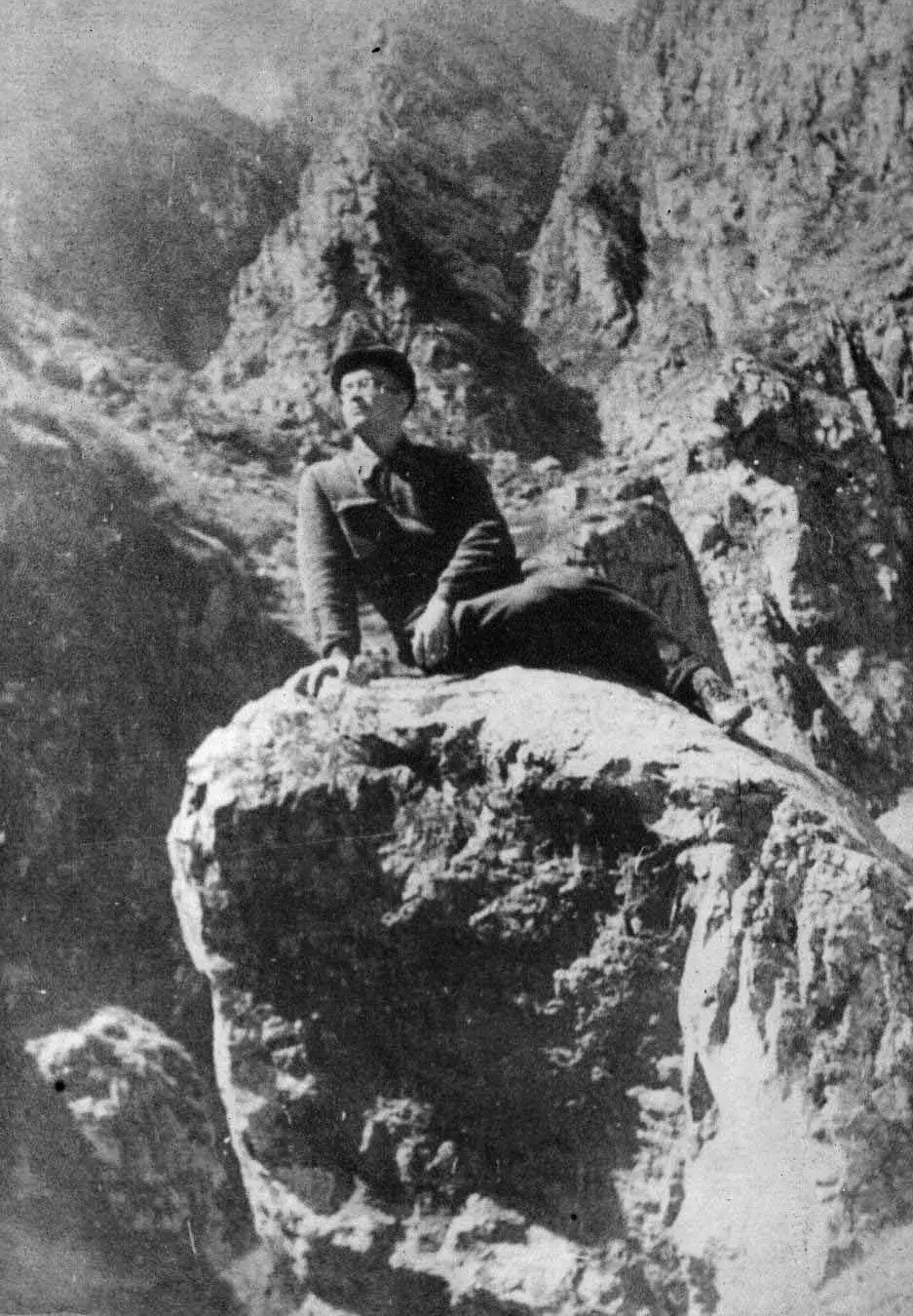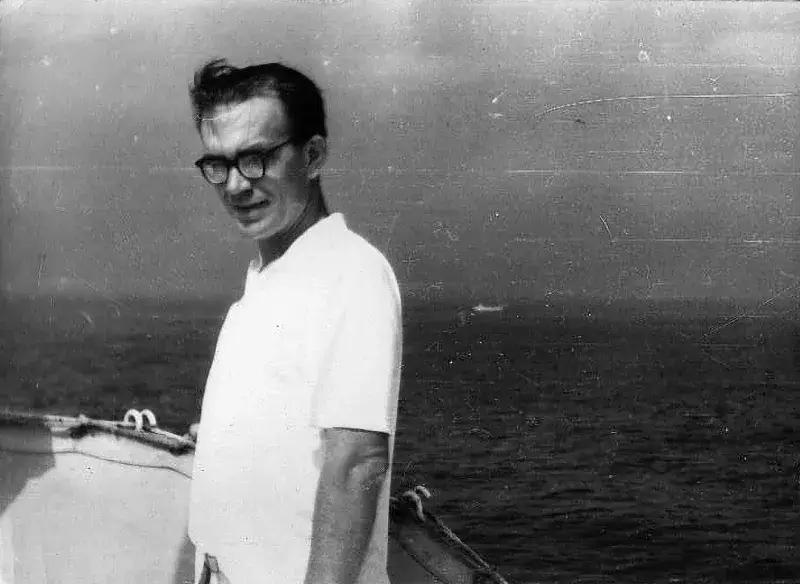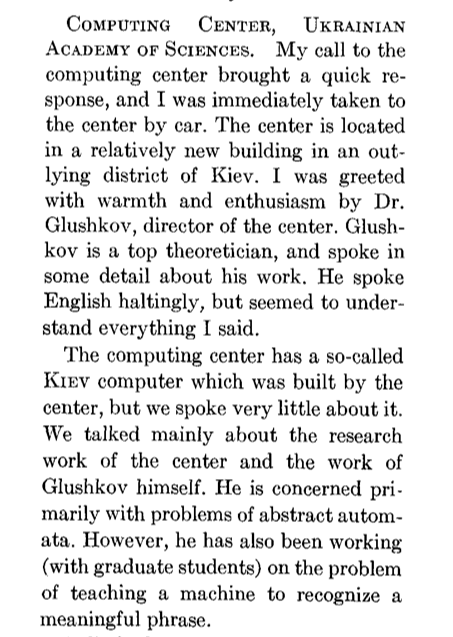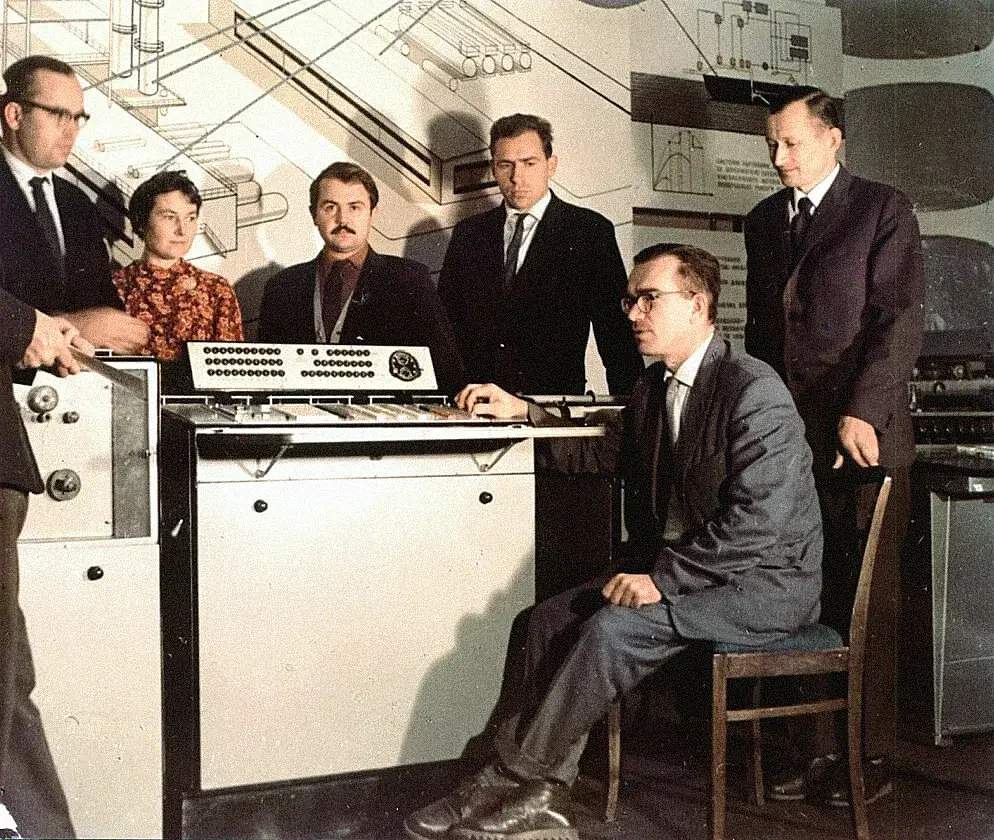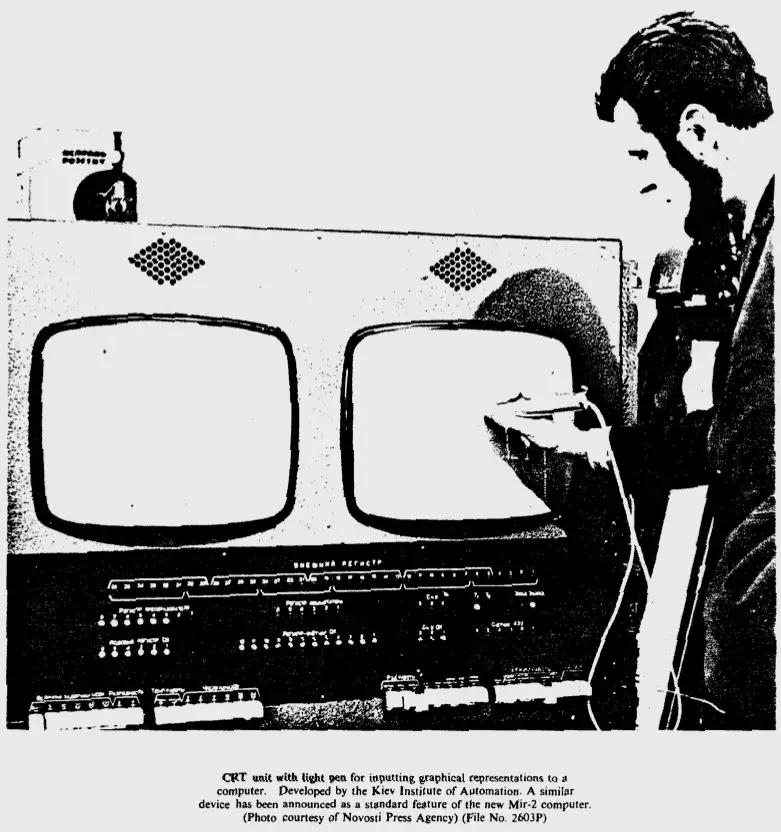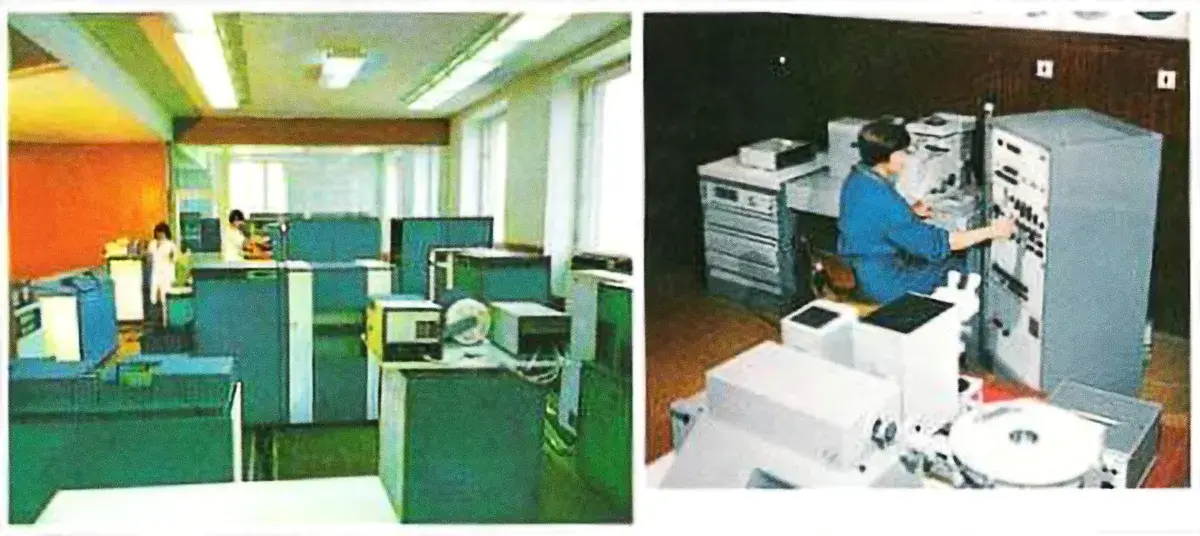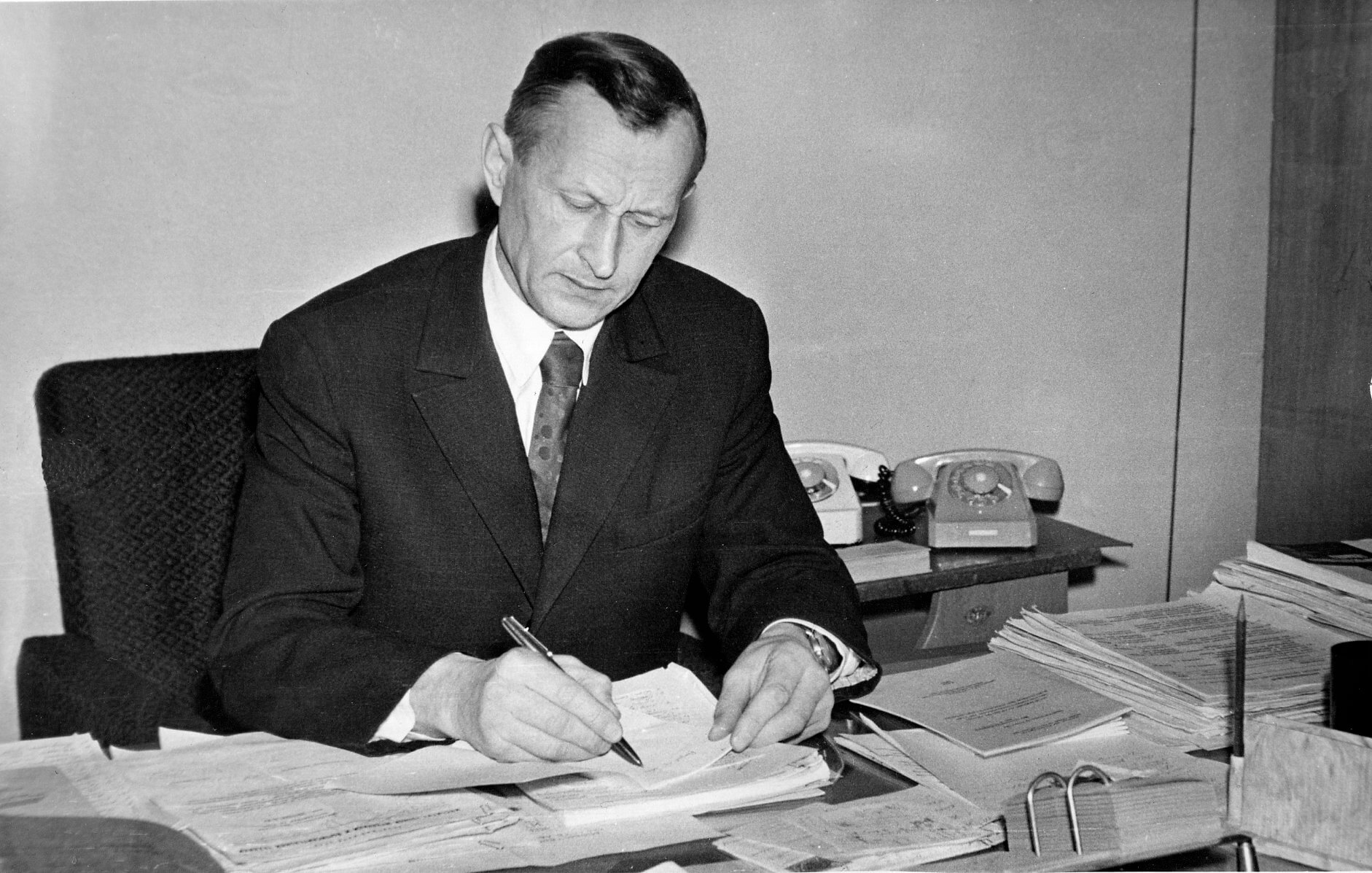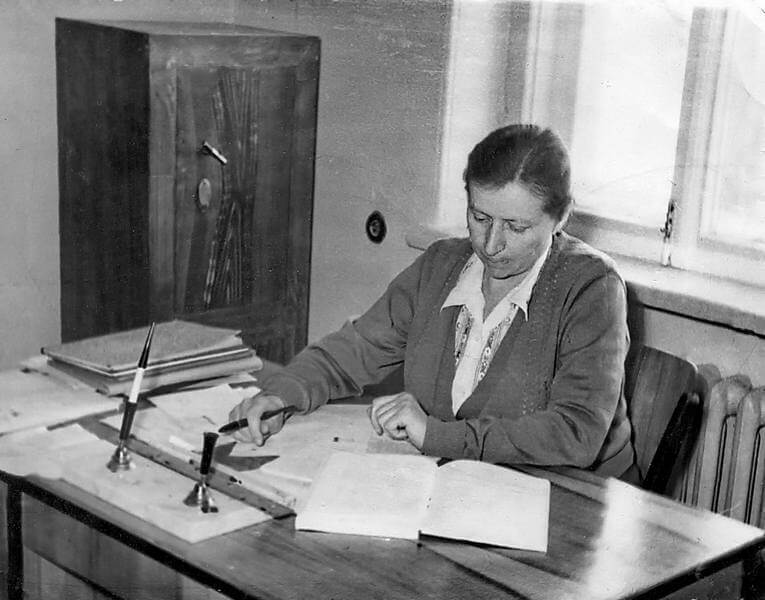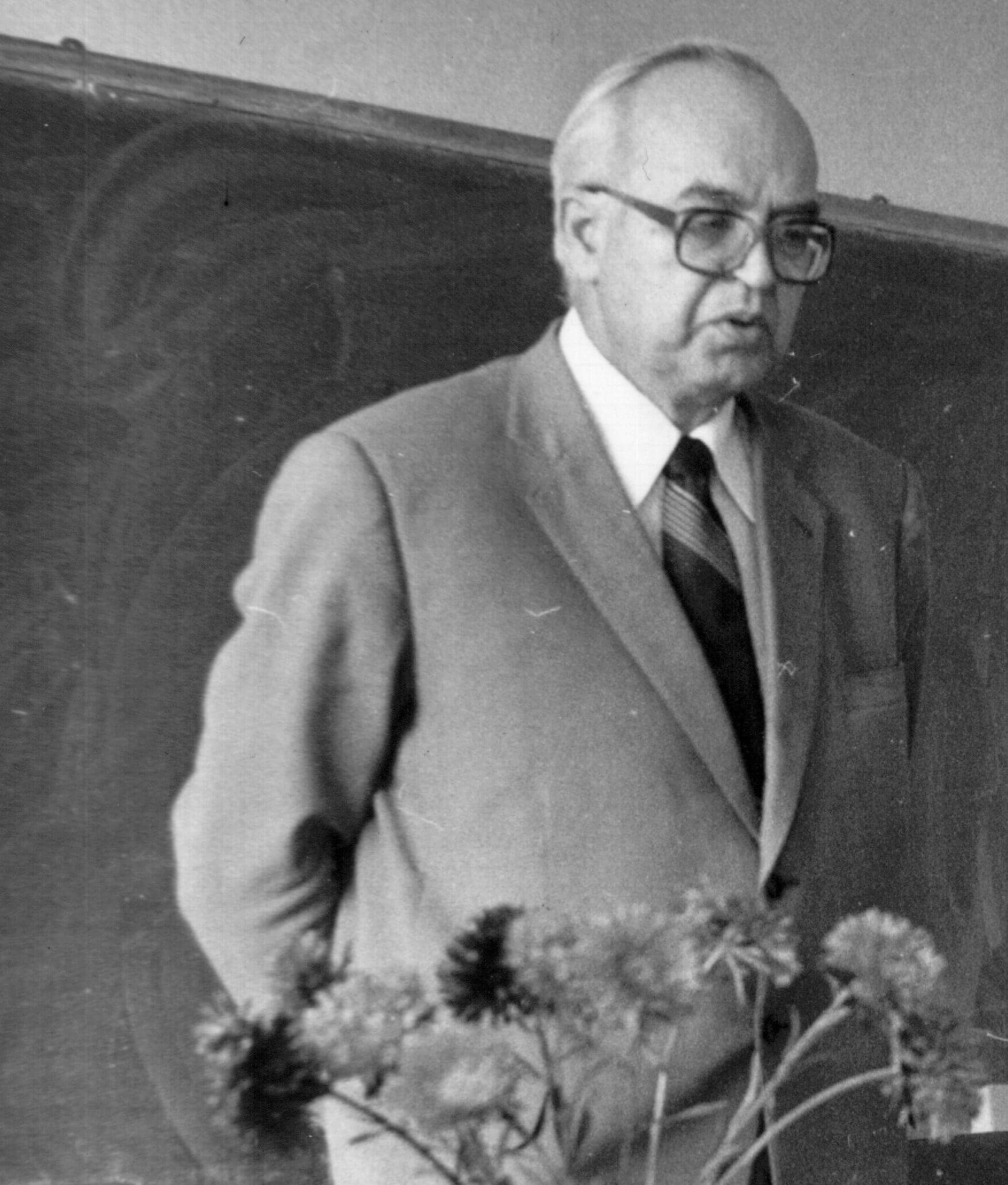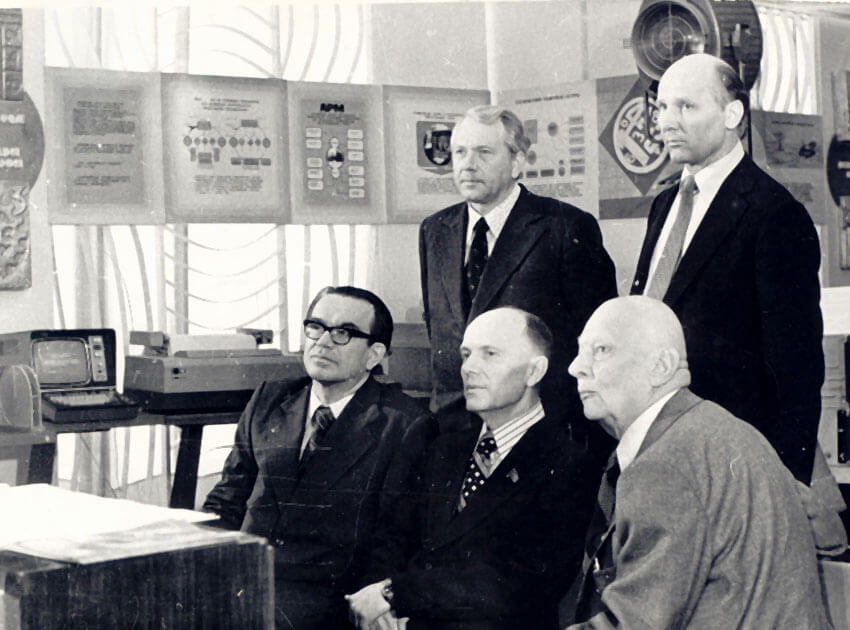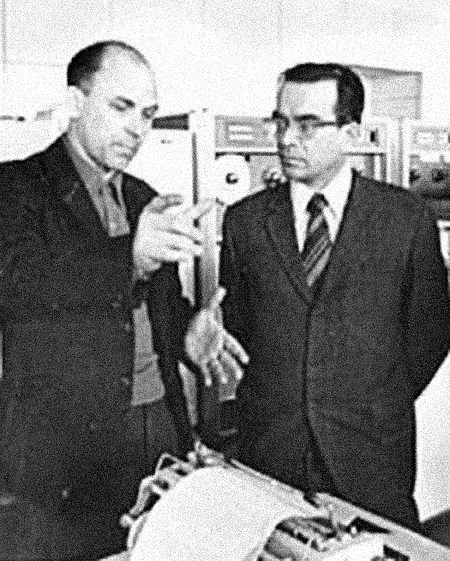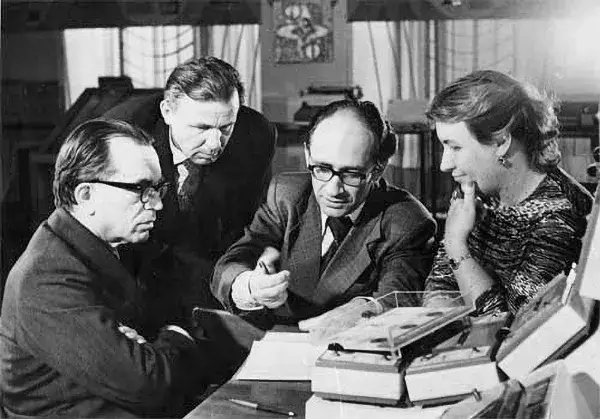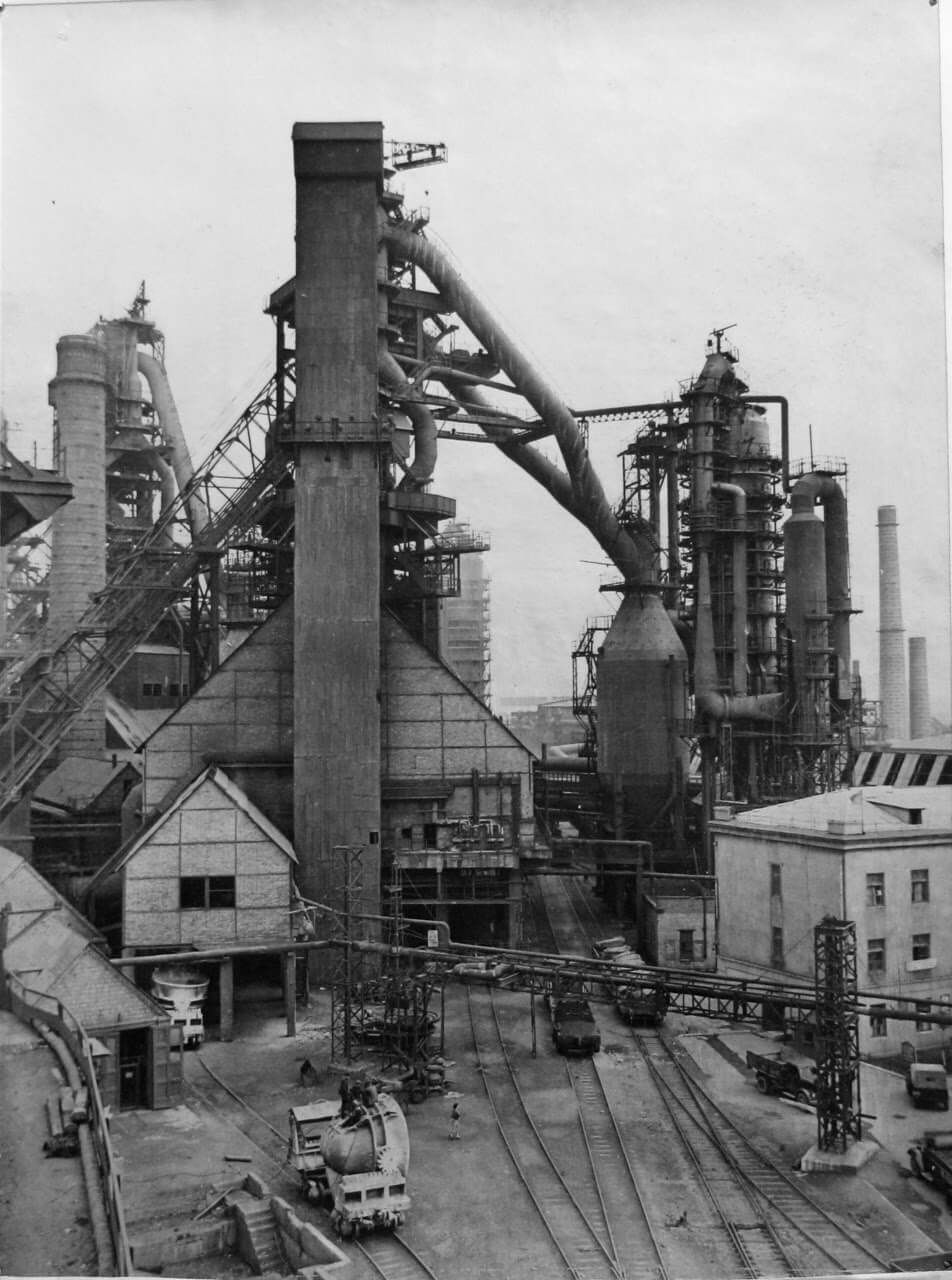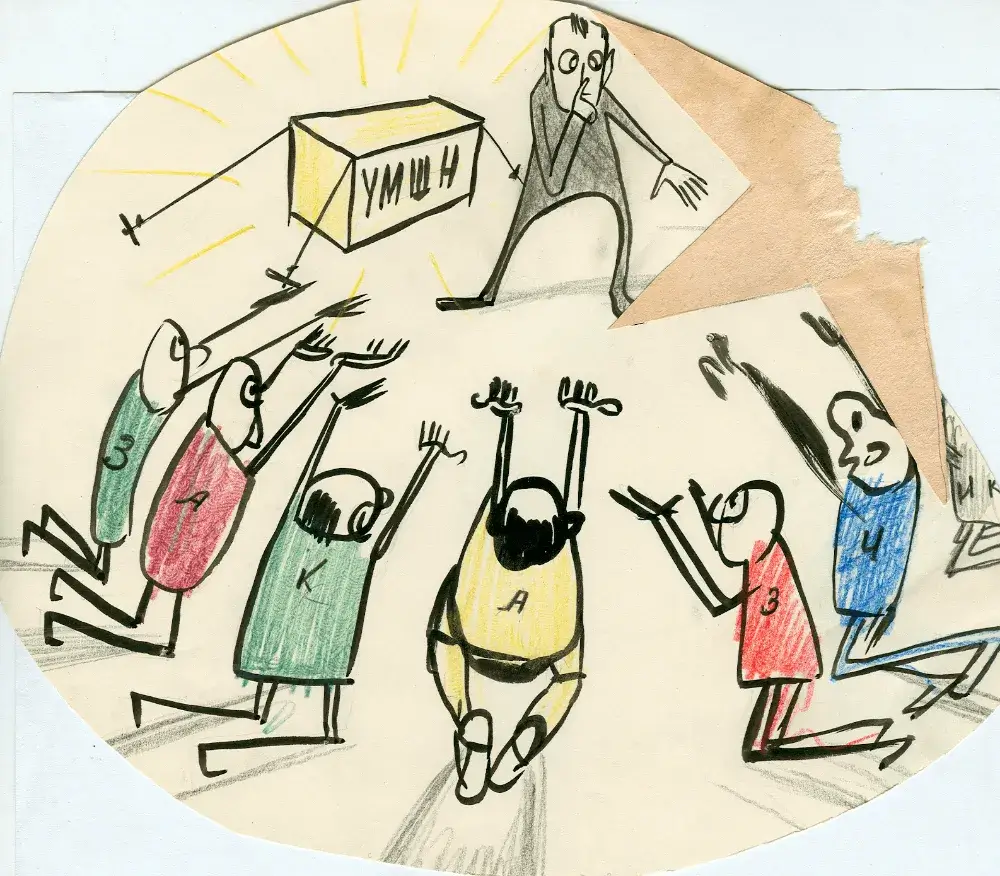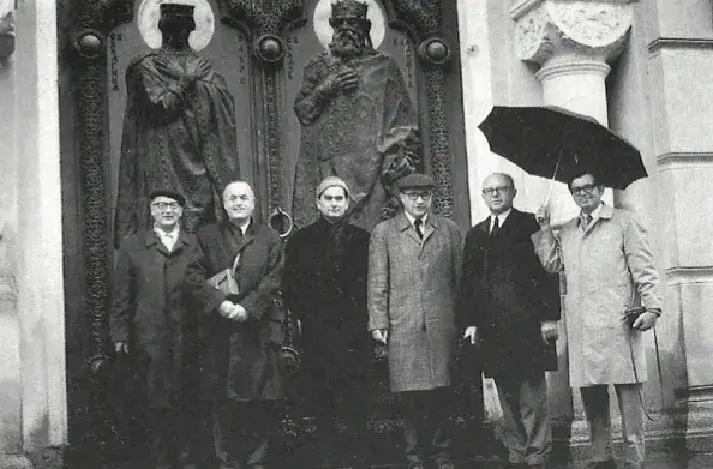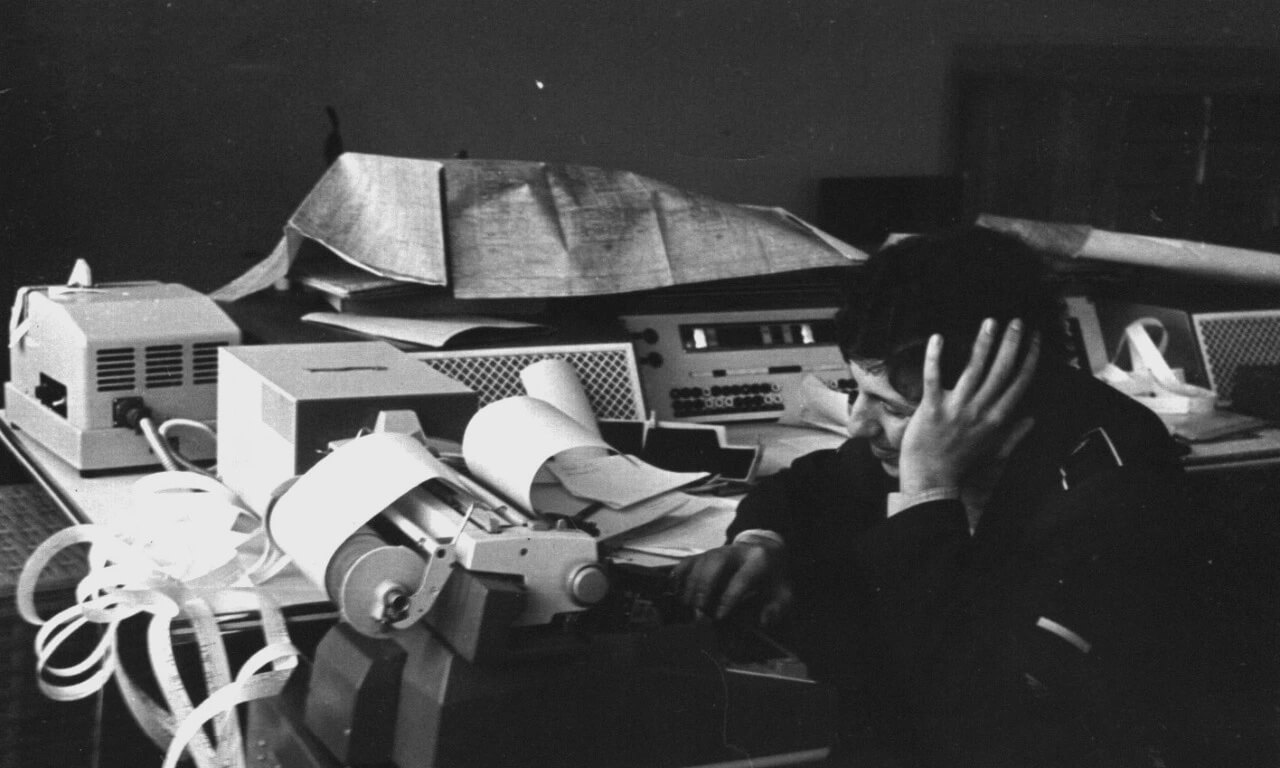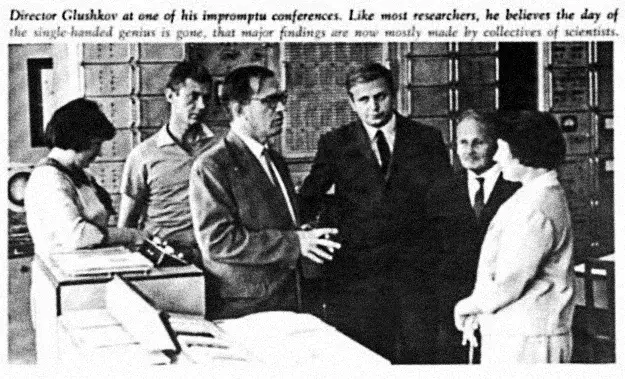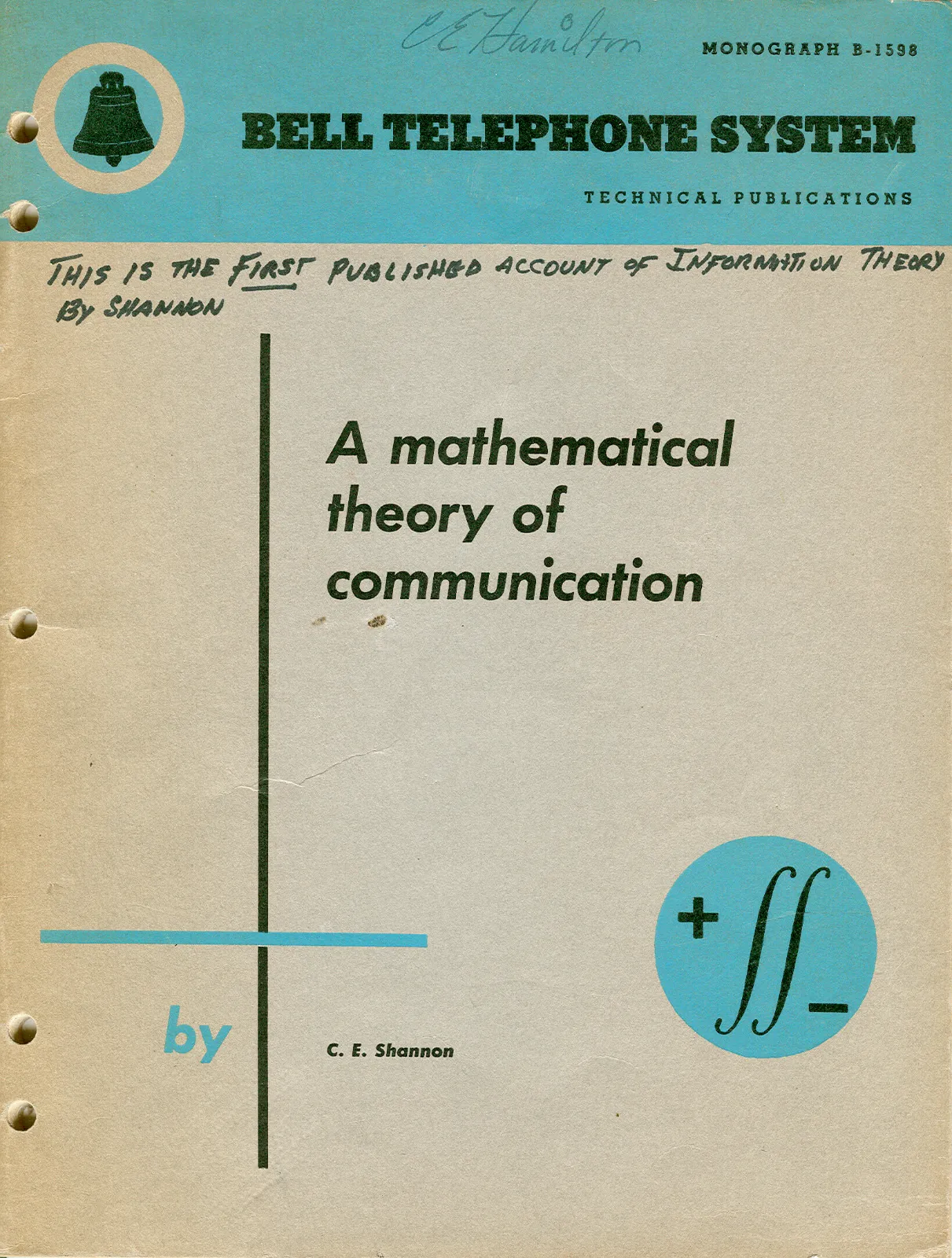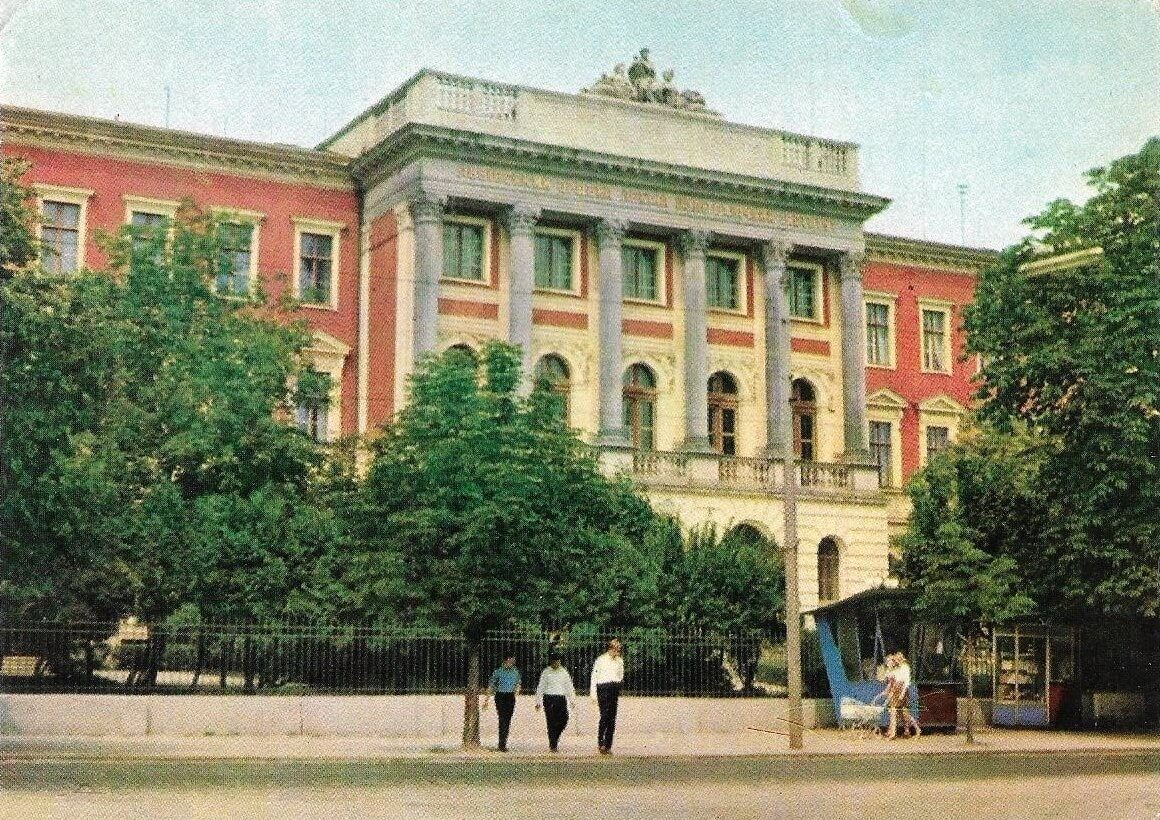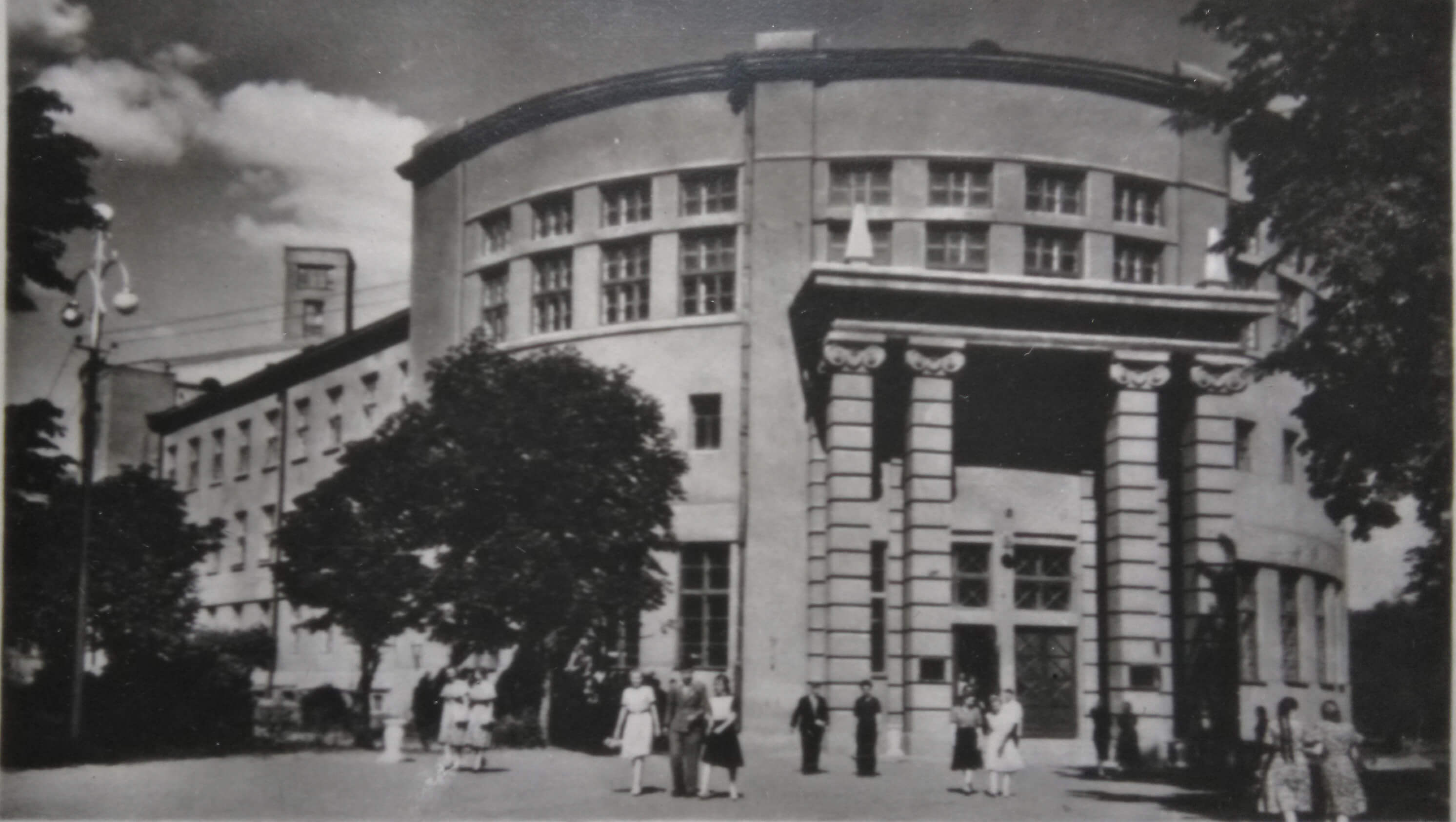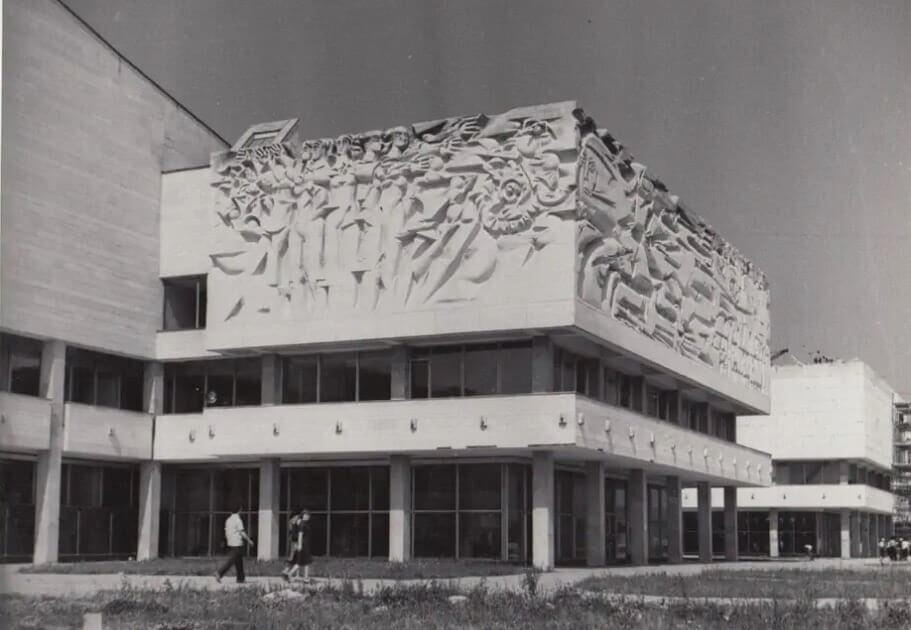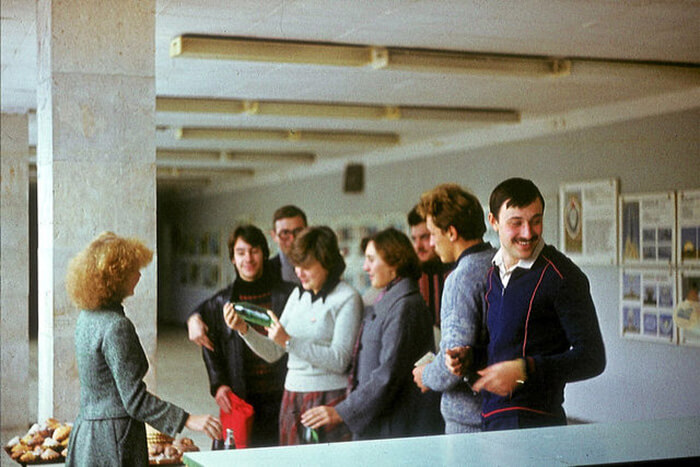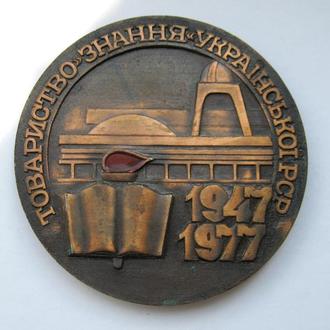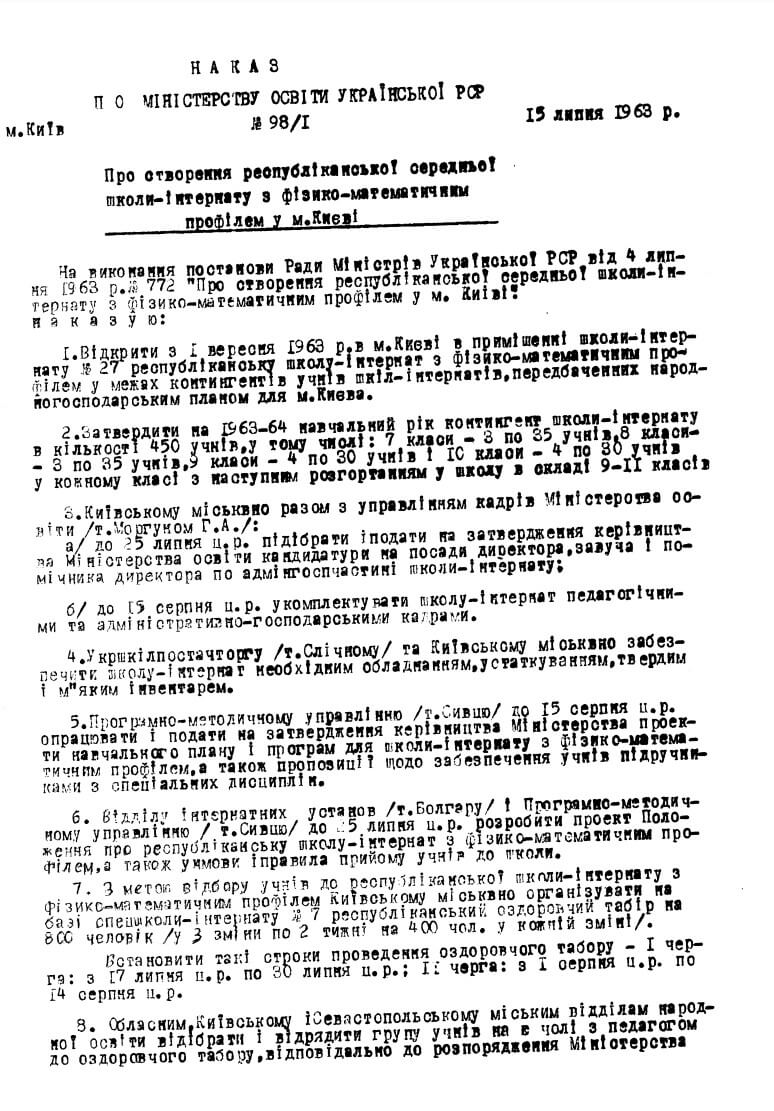The foundation of the online exhibition lies in the voice-recorded memoirs of Victor Glushkov, captured in 1982, shortly before his passing. While certain parts were previously brought to the public, we are proud to present the entire copy, exclusively available in downloadable PDF format.
Our mission was to extend Glushkov's particular ideas to a broader audience, especially among the IT community. For this purpose, we curated his quotes on organizational practices, presenting his story in concise, digestible sections. While we used other published sources, the memoirs remain the project's core.
We do not aim to create a detailed biography of Victor Glushkov but suggest illuminating his personality from a different perspective. Many of Glushkov's approaches to project, team, or stakeholder management still look progressive and applicable to today's IT industry. It is fascinating to delve into the intriguing narrative of how Glushkov navigated resistance to defend his mindset against Soviet bureaucrats, dragging talented managers into the swamp of the communist party's internal struggle. At DataArt, we admire Victor Glushkov's works and ideas, dedicating this online exhibition to his projects and vision, as he proves to have been far ahead of his time in many ways.
Bio
Born on August 24, 1923, to the family of a mining engineer, Victor Glushkov’s interest in technology ignited at an early age. After studying mathematics, he joined the resistance assembling radios during World War II. In occupation, he lost his mother, who was also helping partisans and survived the encirclement of his detachment. Later, this fact did not allow Glushkov to study in Moscow or Leningrad, as all the encircled personnel were labeled suspicious in the USSR.
In 1952, he earned his doctorate by proving the Fifth Generalized Problem of Hilbert and continued his academic career. In 1956, he headed the modeling and computing technology laboratory at the Mechanical Institute in Kyiv, where Sergey Lebedev and his team assembled the first European computer MESM ?Small Electronic Calculating Macine.
In 1957, Glushkov transformed his lab into the Computing Center of the Academy of Sciences. In five years, it evolved into the separate Institute of Cybernetics.
Victor Glushkov successfully combined scientific research and management. His approach to teamwork allowed his institute to become a leading academic organization in Ukraine. In the 1960s and even 1970s, some engineers could access a computer only after assembling it with their hands. Therefore, it took a lot of effort to find specialists with any relevant experience possessing the needed level of technical skill and creative imagination. There was practically no special training, so Glushkov and his deputies traveled around Ukrainian universities, selecting the best students to join the team.
Glushkov's authority in сybernetics allowed him to establish international academic journals Cybernetics and Systems Analysis (1965) and Control Systems and Machines (1972), which became prestigious and continue to come out. Later he was also the editor-in-chief of the Encyclopaedia of Cybernetics. From 1962 to the 1980s, Victor Glushkov issued essays in the magazine Technology to the Youth! He wrote on various issues raised by cybernetics and information technologies around economics, society, management, urbanism, etc. His most visionary ideas were included in Glishkov's postmortem book Foundations of the Paperless Informatics.
The City of the Future
Victor Glushkov’s vision was grounded on a scientific basis, yet enriched with his intelligence and essential trust in the positive meaning of technology development. For instance, Glushkov's idea of computer networks went far beyond mechanical information transfer.
He wrote this in an essay in the magazine Technology to the Youth! in 1980:
"Scarce goods and expensive commodities such as cars, furniture, country houses, etc., could be sold only through special marketplaces and paid solely with a bank transaction. And now try to imagine how swindlers and all kinds of thieving people will feel about it, all those looking for holes in the system to profit themselves through others' efforts. What would they pursue their gray entrepreneurship for? A couple of radishes or an ice cream cone? I cannot presume they would be satisfied with that.
Moreover, citizens of such a city may decide that fancy dining out or liquor should also be paid through the banking system. It should disrupt the existence of those who are offering services for alcohol as a gift (in the USSR, strong liquor sometimes served as currency).
Perhaps, not instantly, but someday, citizens will have a whole set of needed services. There would be a system with cinema, theatre, concert announcements, train and airline timetables. All the tickets would be booked at the same service platform, and of course, they could also be paid at the same place via wire transfer, and such a booking would have a higher priority than cash.
Citizens of this town of tomorrow will not need to waste their time on all these minor issues that consume nearly all of our spare time, and there will not be pointless stress."
Project Management Strategies by Victor Glushkov
In 1956, Victor Glushkov came to Kyiv to head the modeling and computing technology lab at the Mechanical Institute, where Sergey Lebedev’s team had assembled MESM ?MESM stands for Small Electronic Calculating Machine, and its trial launch was carried out on November 6, 1950 , one of the earliest computers in continental Europe, if not the first. Despite being only 33 years old and lacking large team management experience (he used to run a relatively small department at a Forest Engineering Institute), Glushkov was tasked with launching cybernetics in Ukraine and had ambitious plans.
Upon his arrival, Glushkov met Gury Savin, the vice president of the Ukrainian Academy of Sciences, who initially was not sure of Glushkov’s ability to manage a large team. As Glushkov cited for his memories, Savin “doubted whether I could manage hundreds at once, while in the Urals I managed only a few people (and these are pretty different things — heading a small department and an institute — nothing similar in terms of organization). We discussed how I would do all this, he approved, and the Academy hired me.”
"I designed these principles, followed them consistently ever since, and they always led to success. I have not explicitly written about this anywhere yet, although it is a kind of organizational science. I articulated the following principles for myself"
Realizing his lack of practical management experience, Glushkov developed organizational principles to guide his work. There were no sources to borrow the ideas, but these self-made basics have stood the test of time and continue to hold relevance even today.
1. Тhe Unity of Theory and Practice
In his memories, Glushkov emphasizes that this principle is not new. However, it is usually simplified and looked at only from one side. People referring to this unity mostly mean that their ideas need practical applications. Glushkov clarifies that any cutting-edge thought needs to question its own necessity, while any big project needs to be revised for future scalability.
This is how Glushkov put this principle: “Science, especially young science, should not build theories that do not have practical applications, and… one should not start practical work, no matter how important it may seem if it is not preceded by theoretical comprehension. This is what it means: it may turn out that you should do something else instead of the project you have planned, but this work can be more versatile and later cover five hundred applications instead of one.”
Victor Glushkov operated in terms of the whole computer science. But even at the young age of 33 then and although his future Kyiv Institute of Cybernetics started as a modest lab with almost no specialists and minimal supply, Glushkov pursued ambitious goals. Undeterred by the limitations, he forged ahead, driven by the desire to make a lasting impact on the world of computing. Recognizing the potential value of his work for enterprises, particularly massive industrial facilities in Ukraine, he strategized to generate undeniable business benefits. This approach allowed him to secure the necessary funding for his ventures, fueling their growth and significance.
Timeline of the Institute of Cybernetics establishment:
- 1948 – Work initiation on the first European Computer MESM at the modeling and computing laboratory in the Institute of Electrical Engineering of the Academy of Sciences of the Ukraine
- 1950-51 – Launch of MESM
- 1955 – Resolution of the Council of Ministers of USSR to found computing centers in the Union Republics
- 1956 – Victor Glushkov was invited to head the laboratory that was already a part of the Institute of Mathematics
- 1957 – Based on that laboratory, The Computing Center of the Academy of Science of Ukraine was founded as an independent academic institution
- 1962 – The Computing Center of the Academy of Science of Ukraine transformed into the Institute of Cybernetics
2. Search for Shared Components
From the start, Victor Glushkov promoted the idea of using ready-made solutions applied to different projects, with minor adjustments based on the domain area. This approach was worked out on process modeling many research institutions and industrial enterprises were ready to purchase from Glushkov’s lab in Kyiv.
“We were literally inundated with all kinds of draft resolutions from high authorities that we should model this, model that, etc.”
That sounds rather basic nowadays, but in the 1950s, it was not clear at all. Even highly-trained engineers struggled to embrace the shared components idea due to the prevailing culture of electronic craftsmanship at the time. When the Kyiv Institute of Cybernetics was yet to rise, a separate device would usually be produced to automate every single process, and custom software would be built from scratch to operate or model the process it was to control.
When the laboratory was transformed into the Academy of Sciences Computing Center, a special department under the lead of Tadeusz Marjanovich was formed to work on modeling.
“I gave him eight topics, i.e., eight orders and customer cards. And he had six people. He came to me and said, ‘How am I going to fulfill this?’ Glushkov replied that he need to do neither of these, nor the first, nor the third, nor the eighth, but make SLENG ? SLENG is a programing language developed in the Institute of Cybernetics to automate programming processes and descript parallel tools to collect statistics on them. (it was called SLENG later) — a universal language for modeling discrete systems.”
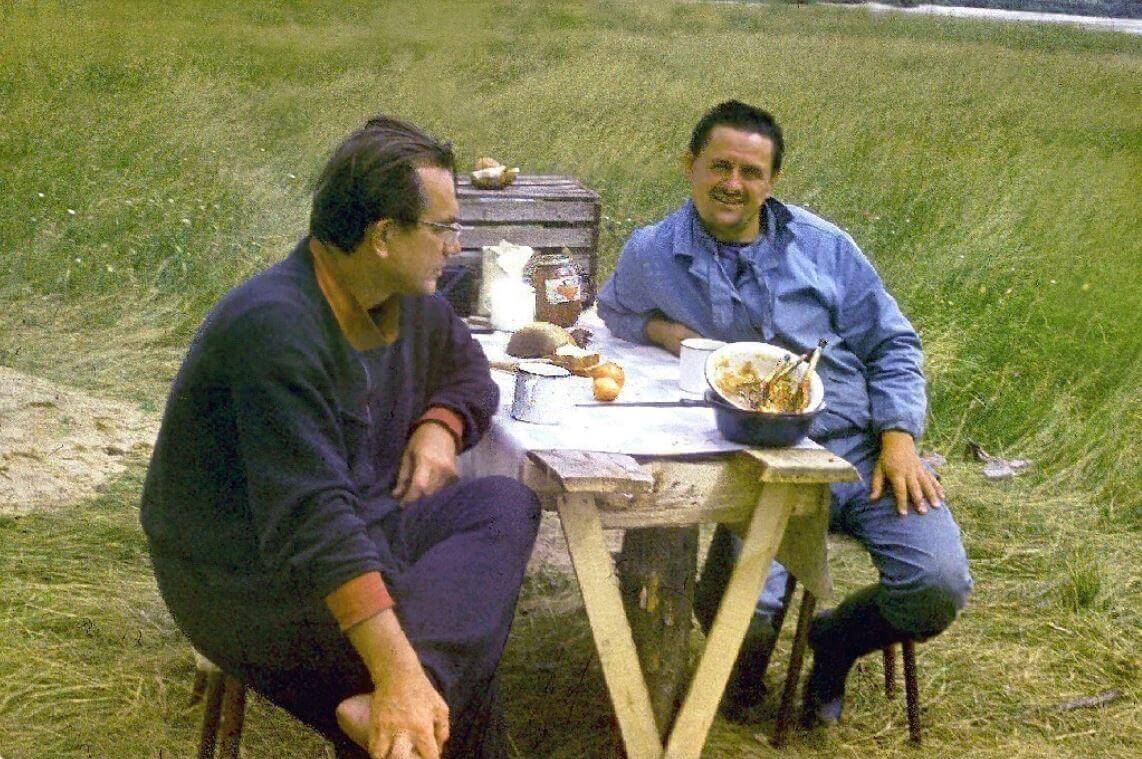
Victor Glushkov and Tadeusz Marjanovich on a picnic. Near Kyiv, 1970s.
Tadeusz Marjanovich joined Glushkov's team after graduation and worked at the Kyiv Institute of Cybernetics until he died in 2014. His works on process modeling were widely applied in many domains, including transportation and
space. Marjanovich also did a lot of research on information systems quality.
The Institute's scientific developments achieved remarkable optimization by sharing basic principles across different projects, guaranteeing widespread applicability. The same approach also served as the cornerstone for the creation of multipurpose calculating devices. However, it is hard to imagine that the very idea of a computer operating various machinery had to overcome strong and cohesive resistance.
UMSHN – DNIPRO – RW-300
UMSHN – The general-purpose control computer "Dnipro" ?used to be written as “Dnepr” was the first semiconductor-based device in the USSR to manage various technological processes. Its mass production started in 1961, about a year after the American Thompson Ramo Wooldridge Inc. brought to market its RW-300, which was very similar to the "Dnipro" yet unfamiliar to the designers in Kyiv. Glushkov recalled this launch in his memoirs, "That was one of the moments when we managed to reduce to zero the existing gap, albeit in one but critical direction."
3. Тhe Unity of Long-Range and Short-Range Goals
This principle was one of the basics Glushkov designed on his way to Kyiv, related to the theory and practice going together, yet approaching the issue from another angle. It focuses on the estimation, i.e., the time needed to fulfill a particular research or an IT project.
“One should not undertake any small individual works, even if they have many practical applications (i.e., they satisfy the first principle)"
He explained the principle as following: "If one cannot see the continuation of these works in the future. The other side of the principle is: Long-term research should only be set if they are broken down into stages, with each step promising a self-sufficient scientific and practical significance.”
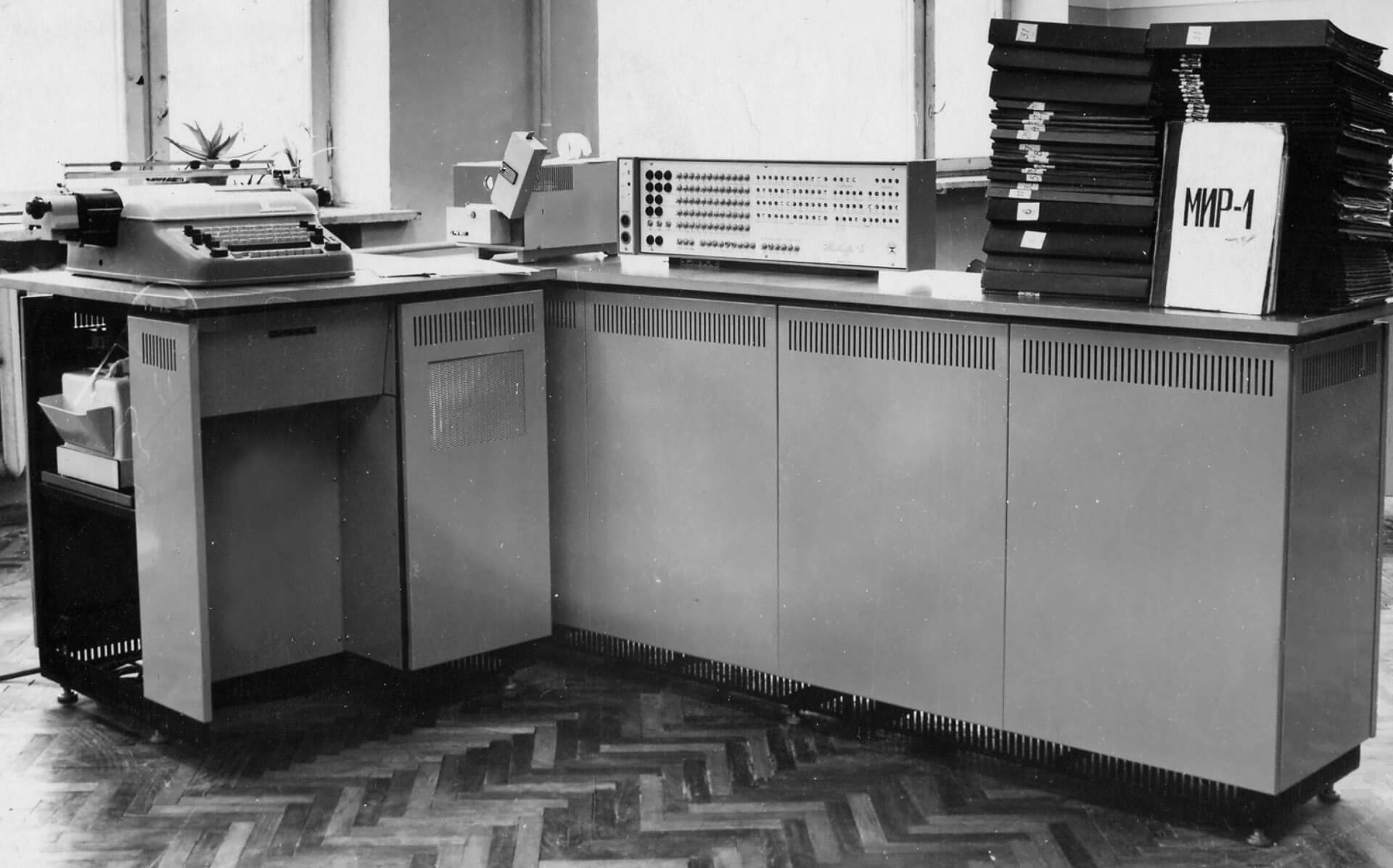
Victor Glushkov aimed to bring computer language closer to mathematical terminology, allowing engineers to communicate with the computer using the usual mathematical formulas. This idea resulted in the development of the MIR series of computers, with the abbreviation MIR for the "Machine for Engineering Calculations."
The idea of splitting a strategic project into smaller self-sufficient operational tasks allowed the Kyiv Institute of Cybernetics to outline a program for intellectualizing machines. That means they gradually increased the capability of the computers they worked on, getting to competitive Mir-1 and Mir-2 machines for engineering calculations.
Victor Glushkov believed that all programs on robots were to be built the same way as short-term projects should never obscure the ultimate mission, “You can solve the problem of vision and hearing, but fail with another issue, say, finger movement — and this work will be useless from the practical point of view and even from the perspective of fundamental research because you cannot study feedback, etc.”
4. Avoiding Downtime
Upon his arrival to Ukraine, Glushkov took on an unprecedented project, managing it with remarkable efficiency. To ensure swift progress, he wisely divided the project into several flows, launching them in parallel. As soon as the development of the first calculating machine started, Glushkov demonstrated his foresight by concurrently addressing personnel training, preparing the production line, and setting connections with future customers.
“Right away, when the factory premises and the design bureau were allocated, I arranged my own lectures for the engineers of the design bureau — first of all, on machine design and multipurpose devices.
At the same time, work with the plant employees and technologies was carried out. Simultaneously, I took care of the selection of an automation object. In total, four objects were selected: Mykolaiv Shipbuilding Plant (sheet metal cutting in lofting), Dneprodzerzhinsk ?now Kamianske. Metallurgical Combine (converter control), Severodonetsk Chemical Plant (artificial fiber), and Donetsk Soda Plant. Besides, the Dneprodzerzhynsk ammonium nitrate plant was added later. Together with them, we organized work to prepare for the use of computers.”
Glushkov’s distinctive approach to parallel tasks set him apart from many traditional leaders of his time. This meant his team always maintained a clear vision of their objectives, understanding the purpose of their system, its intended applications, how users would interact with the final product, and what value they must provide.
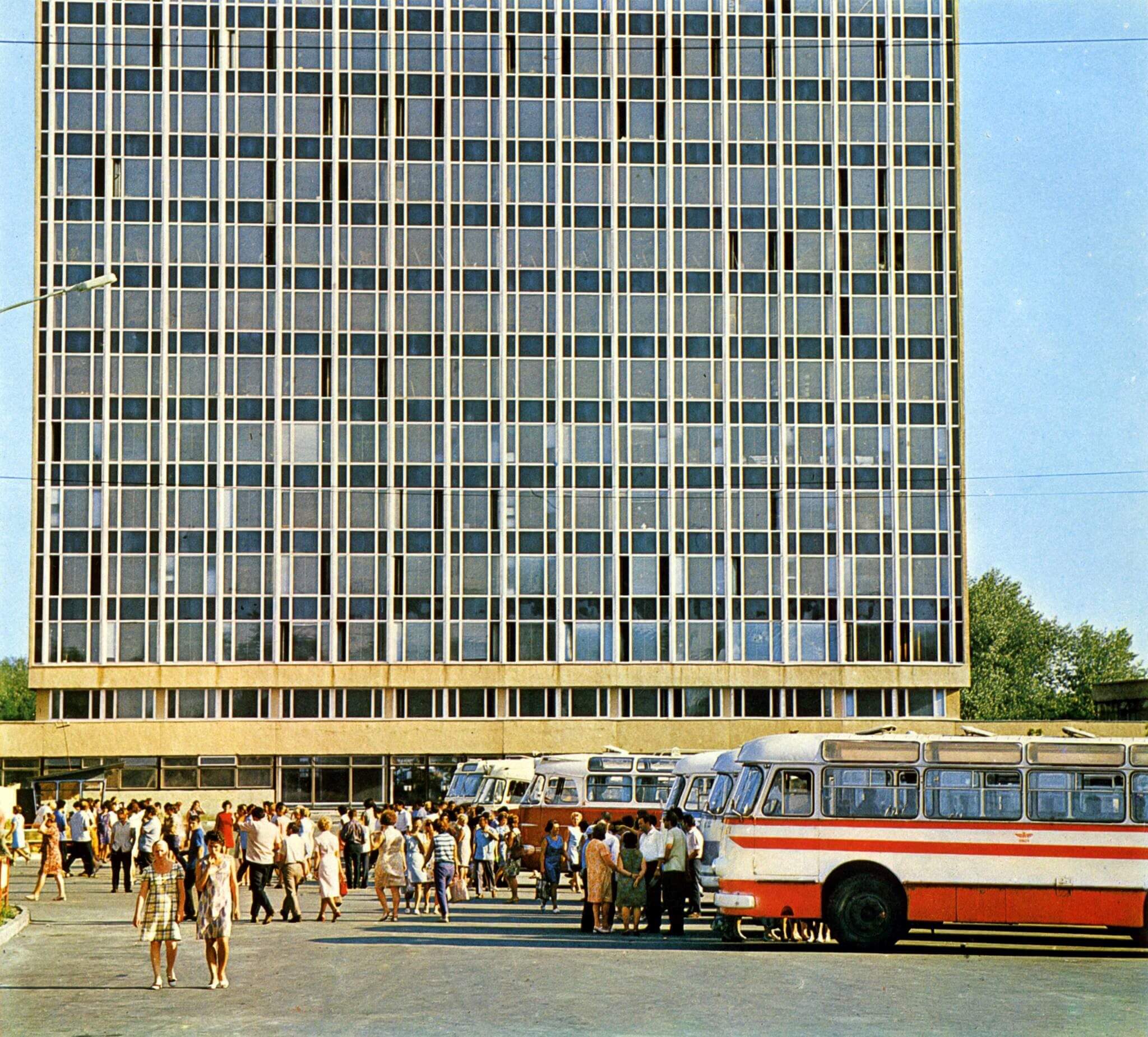
While scientists were designing the new "Dnipro" computer, a plant for its production was already under construction. That was VUM (Stands for computing and control machines), the first enterprise in Ukraine to manufacture electronic calculating devices. Nothing like that was initially planned for Ukraine, but the local government initiated the new industry upon the insistence of the 33-year-old Glushkov. Later, VUM produced MIR computers for engineering calculations; and in 1972, it was transformed into the Elektronmash Association. The plant was active until the 1990s. Elektronmash plant (previously VUM). One of the main buildings, 1973-1974, photo by Boris Gradov.
5. Upholding the Right Solution
In 1959, Glushkov's persistence in promoting his idea of a universal control machine faced hostility from the scientific community. Traditionally oriented researchers and designers could not believe that a computer could be movable and operate in dusty factory premises without air-conditioning and, most importantly, work for different production processes with a positive outcome. But at that time, Glushkov’s associate Boris Malinovsky started working on semiconductor elements for electronic computers, making planning an absolutely different type of device possible.
“We bravely undertook to solve this problem, despite the surprisingly unanimous opposition. That is, practically no one supported us.”
However, he stuck to his convictions and secured support from Ukrainian officials and industry leaders. They started a broad-scale experiment to prove the value of a multipurpose machine, while several groups have already begun working on its design.
"We expressed all the basic ideas that later became dominant — first of all, that the machine must be semiconductor, transportable, highly protected, and low-bit (16-bit) — this is enough to control technology in the vast majority of processes. And most important is the idea of a universal remote telecontrol unit — RTU (a set of analog-to-digital and digital-to-analog converters controlled by the machine and connecting the device to the production process). All this became basic in our days."
Glushkov’s determination knew no bounds. When the Dnipro machine was ready for production, he persuaded the director of the Radiopribor plant to commit misconduct. They decided to assemble the first ten copies well ahead of presenting the prototype to the state commission, risking their careers if the project did not succeed. To support his audacious move, Glushkov strategically lined up commissioners from Ukrainian enterprises willing to purchase the computers even if they turned out to be imperfect.
Glushkov explained how it worked in metalwork, “Say, melting steel in a Bessemer converter takes 12-14 minutes, but since the process is fast, it is difficult to stop it precisely at a given carbon content. For example, they make low-carbon steel with 0.3% carbon. If the carbon content is brought up to 0.29%, such steel is only suitable for a bed, while it was necessary to get rail steel for wide application. That is why the operators tried to under-burn: if the content got to 0.35%, they stopped blowing and made an express analysis. Melting lasts 12 minutes, the express analysis lasts 30-40 minutes, and the furnace stands waiting. Sometimes they had to blow it for the third time.
The main task I set here was to reduce the number of blows with simultaneous reduction of rejects, i.e., steel with lower carbon content. We accomplished this task: we increased the converter's productivity by at least 10% using relatively simple algorithms and far from perfect sensors.;”
One of the trickiest things Glushkov managed to arrange those early days in Kyiv Cybernetics was constructing a blocks of simultaneous proccesses to not waste time on just waiting for one of the processes to finish. For instance they were debuging and finalizing the soft, while working on the hardware.
The project involved collaborating with various specialists who helped develop a device for interfacing with the telegraph network. Data from the mobile RTU was transmitted to our computing center to the "Kyiv" ?common spelling in soviet literature was Kiev machine, which had already been operational since 1958. There was interfacing with telegraph channels, and we could come to any enterprise, and usually, large plants have a separate connection to the telegraph line. By extending the telegraph line to the operator's workplaces and using digital code on teleprinters (Baudot), they successfully connected the sensors directly to the Kyiv machine. This allowed them to debug the software in parallel with the development of the Multipurpose Control Computer (later — "Dnipro-1"). Although the software was not initially intended for the "Dnipro," they ingeniously overcame all the difficulties, focusing on conquering the fundamental challenges in the control algorithm.
Team Мanagement Principles by Victor Glushkov
Under the guidance of Victor Glushkov, the organization underwent a remarkable transformation, from a modest lab to a prominent computing center and then an institute, leading the entire cybernetics not just in Ukraine, but also beyond its borders. This expansion was marked by the continuous expansion of his team, reaching a formidable size of thousands of people at certain junctures. Glushkov believed his managerial success was not a coincidence or a direct consequence of his charisma. Instead, he saw its foundation in the operational principles he articulated upon his arrival in Kyiv in 1956. These principles primarily focused on the domains of team composition and effective communication with the colleagues under his leadership.
1. Decentralized Responsibility
The idea of fully delegating specific areas to his deputies did not take long to crystallize in Glushkov’s mind. He adhered to the decentralized responsibility concept for almost thirty years, even though it was not easy to transmit this idea further. Glushkov recognized that not all leaders embraced this approach, though many intuitively came to it, exactly like himself.
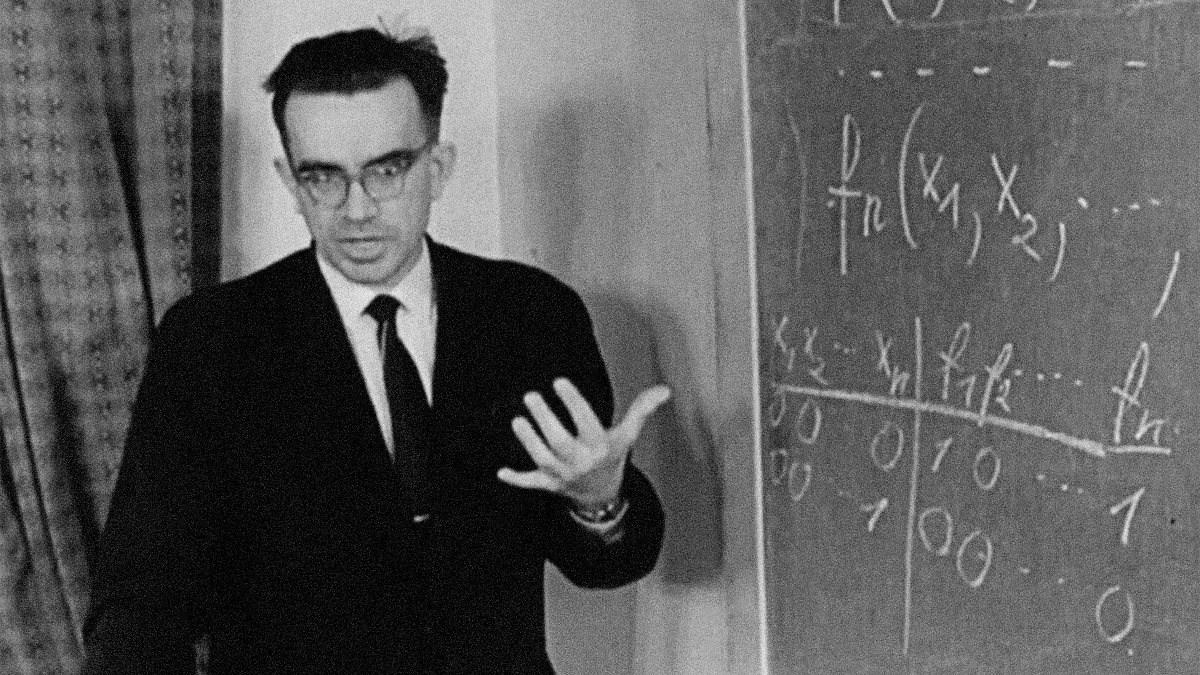
Victor Glushkov explaining his ideas at a seminar in the institute, 1960s. Unknown photographer
Victor Glushkov was sure that a senior manager could not cancel his subordinate's decision after a five-minute conversation. And to a certain extent, this statement was in direct contrast to the typical style of Soviet governance style ? Тhe command-administrative system used in managing economics and the state in the USSR implied rigid hierarchy, strict subordination, centralized decision-making concentrated at the top level, and subordinate managers’ initiative being limited . Glushkov stood resolute, refraining from micromanagement unless systematic misunderstanding arose. He outlined that people typically played on leaders' egos for personal gain and urged emotional self-control.
“I allocate areas and appoint managers with deputies, etc., responsible for different research. Then I try to minimize my interference. Even if I see that they are doing everything wrong, I do not direct them specifically, saying that this issue should have been solved this way, but relating to some integral indicators.”
He claimed to have successfully articulated a two-stage management hierarchy, “i.e., where I am at the top, then someone else, and then the implementers. But it does not work this well with three or more stages. Because, say, no matter how much I teach [my deputies] … to use the same techniques, they cannot do this. They are always bogged down in trying to cover everything themselves. The issue of housing is a question of the real power in the institute, as the saying goes, and that is why nobody wants to miss it. At the same time, more and more things are piling up from above, and they are poorly solved. When I propose to hand specific issues over to someone, they cannot believe that this someone will manage them well enough, i.e., it requires more self-possession and an organizational mindset.”
2. System Еrrors Handling
Being very careful about time, Victor Glushkov was ready to invest an hour explaining his decisions to his subordinate managers, emphasizing the need to step back and take a broader picture rather than getting bogged down in particular cases.
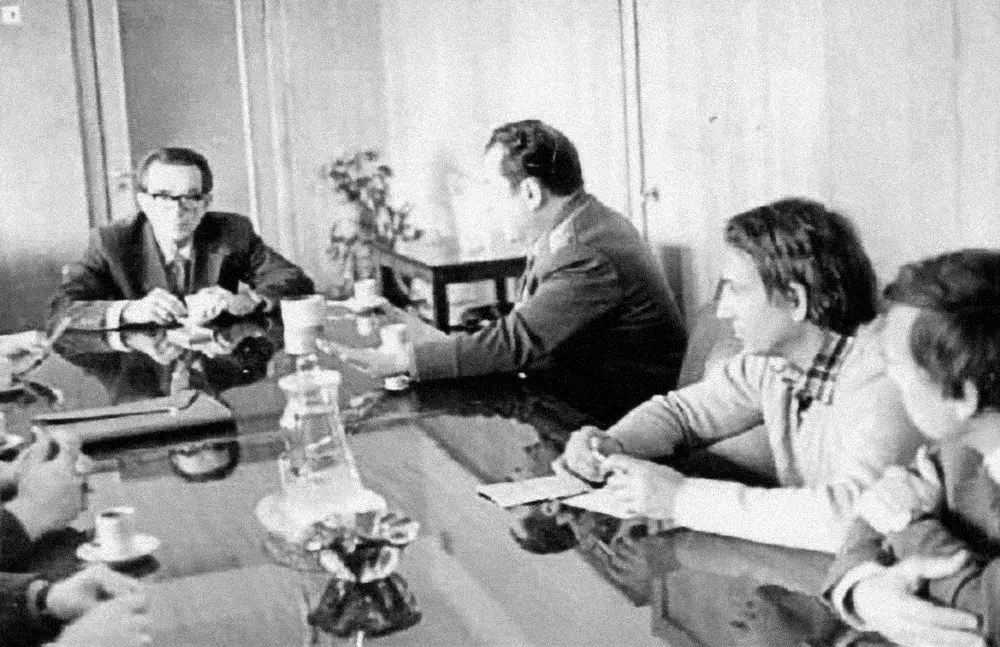
Victor Glushkov at a meeting with colleagues, 1960-1970s. Unknown photographer
Glushkov clarified, “As in scientific work, I apply them to summarize the fundamental basis for many practical applications. If these were mistakes, we need to find the root cause, and after that, we can make claims.”
“Now, when something goes wrong in our institute regarding management, I do not focus primarily on particular mistakes and individuals — it happens that a person simply cannot cope and needs to be replaced. Most often, it is that there is no management mechanism.”
3. Mastering Procedures
Glushkov identified himself as a skilled master of procedures. While he delegated specific tasks, he expected adherence to the structured processes he laid out. He was willing to engage in tasks that promised scalability and future efficiency gains for the organization.
In his memoirs, Glushkov illustrated it with a clear example of space distribution within the institute, which was always an issue of the highest priority. He noticed that neither his deputies nor the maintenance department could allocate anything for six months. Then Glushkov came up with a mechanism:
Procedure – monitoring – scientific approach
“One person, a technical worker, keeps files of equipment rooms. The chief engineer responsible for the equipment is charged with developing technical standards, determining how much space it should occupy and what kind of workplaces it has. So, that employees would not have to plan new workplaces because there was often double or triple counting, etc., which was the basis for all the frauds. After that, priorities are determined (based on the results of socialistic competition, etc.), and areas are distributed under these priorities. The average amount per person is calculated; from this average, increments up and down are given according to the priorities. And following this, the area is distributed, that is, almost automatically.
Now, we need to decide how to monitor usage. I suggested that Mikhalevich use the theory of probability, random functions, random sampling, etc., to organize the case. A program with random numbers is made on the machine; every week, it gives room numbers to be checked by special commissions from the maintenance department. They go there, pull the handle — it is closed. Where are the employees? Some work from home, others are on an extended business trip. They write down how the space is used, and during the subsequent redistribution, they reduce the shares of those who used it worse and increase the claims of the rest.”
4. Authority and Liability
Besides delegation, Glushkov saw another essential point in responsibility decentralization. He recognized a prevalent issue in most hierarchical systems (and there were no other officially recognized systems at the time) — competent managers bore the brunt of issues even when they occurred several tiers below them, i.e., out of the manager’s reach.
“In particular, the director is accountable for everything in the institute and may be reprimanded by a higher authority for some misconduct that he had no chance to prevent… And the method of responsibility decentralization, as we understand and apply it, is that if, say, a deputy director is entrusted with a particular area and something happens there so that it is necessary to impose a penalty, it should be imposed on the direct perpetrator of this misconduct.”
While he stressed the importance of owning their decisions and addressing subordinate incompetence, Glushkov directed blame not solely at isolated incidents but at the structures, compositions, and training approaches they devised for their teams. “The work with personnel is a direct responsibility of a leader.”
Glushkov was confident that the focus on people allowed them to build the institute in a minimal time and succeed in all the major projects it was assigned with.
5. Teamwork Promotion
During the institute's formative years, Glushkov's hiring approach proved astute. When he was personally involved in recruiting, most engineers and researchers stayed long and proved to become highly qualified experts.
Glushkov acknowledged the value of particular achievements but maintained that strategic advancements hinged on cohesive teamwork: “When I selected people to work at the institute, I paid attention not so much to the proximity of the specialty as to enthusiasm and potential, and also… to the non-quarrelsome character, to the ability to work in a team.”
Glushkov acknowledged the value of particular achievements but maintained that strategic advancements hinged on cohesive teamwork.
At the same time, it meant that he was ready to eliminate the people who did not fit in. And the very start caused several conflicts with the old Lebedev’s guard. It cost effort and time. In one case, Glushkov personally led an operation to kick out a technician he believed would keep writing anonymous complaints.
Yet Glushkov was sure that it was worth that, “This immediately helped to improve the climate in the team, and for a long time, we did not have a single anonymous complaint. In the past, it was simply impossible to work — all sorts of commissions kept holding their meetings.”
6. Attraction and Retention
“V. S. Korolyuk hesitated for a long time but ultimately did not join. I remember how Mikhalevich and I took a long walk through the forest in Feofaniia, and I told him that he would become a doctor of sciences later than his colleagues at the Institute of Mathematics. But that his further advancement up the academic ladder would be faster, and that he would vote for Korolyuk (in the elections to the Academy of Sciences of the Ukrainian SSR), and not vice versa. In the end, Mikhalevich joined us. All this gave us the opportunity, using exceptions and the positive attitude of the Science Department of the Central Committee of the Communist Party of Ukraine, to organize the training of personnel. It included being allowed to take post-graduates to candidates of science, and we loaded them all with post-graduates. Besides, the candidates were needed as soon as possible, so I started searching in other cities and among the invitees. Thus, for example, I found V. A. Kovalevsky, and Malinovsky found V. I. Skurikhin and introduced him to me, as it was his university friend.”
Glushkov mentioned in his memoirs an unprecedented decision of the united party committee of the Academy of Sciences of the Ukrainian SSR that the residential building II/3 on Bolshaya Kitaevskaia is entirely at the disposal of the institute contributed significantly to the attraction and retention of new personnel. It was done for the first time; the usual practice in the Academy of Sciences is that each institute is allocated one, two, or three apartments in one house. "We could accommodate our leading staff, which also contributed to strengthening the institute.” — he added.

View of the Velyka Kytaivska street in 1984. Photo by Vasyly Galayba. Source.
Despite the overall success, not everything went smoothly in Victor Glushkov's relations with his associates. Boris Malinovsky recalled an intriguing incident when Glushkov commented on his nomination to become an academician, reflecting, "Not every director has courage and nerve to support his contender!" Many years later, Malinovsky pondered this moment, seeking to comprehend why Glushkov instantly changed his attitude towards him after several years of cordial collaboration. Although Malinovsky found the experience to be somewhat unfair, he recognized it quite characteristic.
Customer and Stakeholders Relations
The Soviet scientific research and tech development system was a tricky combination of academic institutions and industrial ministries that sometimes changed their names and structure. The Academy of Sciences allocated substantial budgets for fundamental investigations, but an institution's success mainly depended on its administration's ability to balance between different authority groups. Victor Glushkov recalled many situations that, despite all the differences between the command economics and current business, could be regarded as impressive examples of stakeholder management.
1. Customer Engagement
From a distance, it may seem that administrators in the USSR did not have to care about marketing their products and reaching clients to sell them. However, there were markets for any goods, and though dominated by governmental orders, they were primarily untransparent. The harder task lay in securing customers for a complicated system. At the same time, substantial orders from wealthy organizations were essential to generate funds for employees’ bonuses and housing, scientific experiments, and facility expansion.
This is how Glushkov formulated his idea of customer engagement: “Since I tended to industrialize production, alongside working on the prototype for Kyiv for the Computing Center, I immediately decided to find a wealthy customer who would finance and supply us. Dubna, the Joint Institute for Nuclear Research, became such a customer. The institute's administrative director visited us, and we signed a contract and built the second machine for Dubna. This way, we immediately resolved the issues of financing, material, and technical supply, which would have been impossible to solve within the framework of the Academy of Sciences.”
Marketing the Kyiv computer involved a robust campaign targeted at Ukraine's key industrial plants, particularly their leadership. It started with an experiment showcasing computer-assisted process management, which proved its efficiency. Glushkov recalled, "The plant directors immediately demanded that we continue these experiments because it was profitable for them. But we said no, we needed a machine for calculations. Here you are, please; the Radiopribor plant is making a serial machine; you can sign up in line. And the people poured in. So we created the market even before the prototype was ready."
2. Concerning Stakeholders’ Mindset
Although Victor Glushkov operated at a national level and was used to thinking big, he displayed a remarkable penchant for detail, including understanding stakeholders' career plans and psychological inclinations.
In his memoirs, Glushkov recalls designing a remote terminal unit. The project was simplified, as the device could be made one-sided. “We thought not about replacing a human with a machine in the upper control loop but about making an assistant who would advise the master operator on optimization of the control mode. The master operator still had to turn on the control knobs as we understood people's psychology: the converter is an expensive thing, and no director would allow control of it through an incomprehensible machine. Who will be responsible if the steel freezes in the converter? After all, the converter would have to be blown up, meaning tens of millions of rubles in losses. That is why the commands that were built by the machine had to go through a supervisor.”
For Glushkov's team, it also meant that at this particular stage, they had only to convert sensor readings into a digital code and not vice versa.
To illustrate technology's productivity gains, before the Dnipro computer mass production started, Victor Glushkov orchestrated competitions between the best industrial process operators and the machine.
“For three days, production is managed by the best operators, and for the other three days, by any operator with the help of the machine. The results of working with the machine assistance were much better everywhere.”
Although initially skeptical, the directors of all major plants participating in the test were convinced of the productivity of the cutting-edge technology and the superior results achieved with machine assistance, a testament to Glushkov's grasp of his counterparts' concerns.
Later, this ability to understand others’ perspectives enabled Glushkov to play a trick on some high-ranking Soviet bureaucrats. In 1970, by introducing the idea of a comprehensive hardware and software complex intended for broad domains and adjusted for particular enterprises. The idea met a hostile reaction, as it had no official reference to American practice.
“So, what did I do then?” Glushkov describes in his memoirs, “I met with a representative of a Swedish computer firm ?Presumably in Finland during the preparation of the IFIP conference in Stockholm in February 1974., and they are highly interested in our market. Their own machines are bad, so they buy American ones and try to resell them to us. And the Americans are catching them red-handed. I told them to adopt the concept of a software and hardware complex and announce that their firm specializes in it. You buy a machine from Hewlett-Packard, memory from another company, disks from a third, assemble it, make programs, and sell us the billet. No one can accuse you of resale — you are making a new product.”
“Oh, how they seized on the idea! They immediately translated the term into Swedish. I sent the prints to the State Planning Committee, and they exclaimed: ‘How come it is already in Sweden! Not only in America but in Sweden they have it!’. They raised all the flags in a hurry and called everyone to catch up… and we translated the term back from Swedish.”
3. Addressing the Decision Maker
Very soon after his arrival to Kyiv, Victor Glushkov was ready to present his national computer industry development draft to the Republic’s authorities.
The seven-year plan (1959-1965) ? Economic strategy of the Soviet Union based on strict planning and obligations. The middle-range period for such planning was five years (pyatiletka), but in this case, Khrushchev changed it to seven. did not assume a single computer plant in Ukraine, and in general, computing technology was planned to be developed in Belarus, Armenia — anywhere but Ukraine.
As soon as his first computer design project started, Glushkov went to see Olga Vaschenko, one of the top-level Ukrainian officials. The newly-appointed head of a lab, who was not yet 35, denounced the upcoming Republic’s industry lag. “...we immediately went to Podgorny and decided to organize it — then there were sovnarkhozes ?regional economics governance units, and the Republic could determine it for itself. Vashchenko found the director of the Kyiv plant Radiopribor and instructed him to prepare premises and the design bureau to participate in developing and manufacturing the machine. A corresponding decree was issued, as well as another decree of the Central Committee, prepared by us, on constructing the VUM plant with its personnel to be trained within Radiopribor.”
Within a few days, Glushkov guaranteed a new industrial project, including an entire factory built for his holding. That was due to his readiness to take responsibility for a completely new domain, i.e., in the case of high uncertainty. And it also took courage to go directly to the government leaders.
Glushkov’s willingness to confront customers for the greater good was evident when he proposed a universal language for modeling discrete systems. The customers, representing major enterprises, were unhappy about waiting for that. Then Glushkov got them together and “did some educational work with them, and they agreed that this was exactly what they needed, and in fact, they were responsible for the wrong explanation of their requirements in the customer cards.” Educating these clients on the language´s merits, guaranteed hundreds of further practical implementations of the institute’s research.
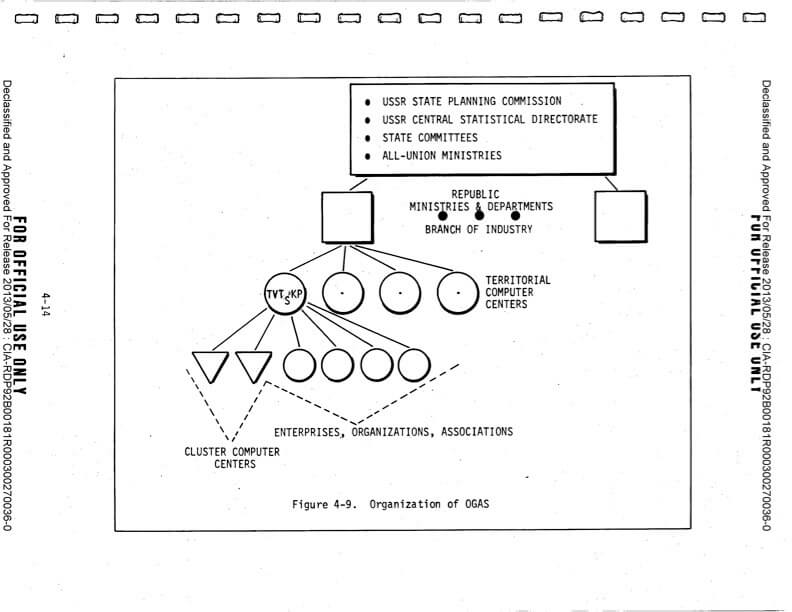
Technological foundation scheme of the OGAS project from the declassified CIA report Summary of Soviet Digital Switching, June 1986.
Starting in 1962, Victor Glushkov developed the idea of a unified economic management system. His project of the National Automated System for Computation and Information Processing (known as OGAS), called for the creation of a network with tens of thousands of terminals all around the USSR, computing centers in big cities, and the head one in Moscow accumulating all the information. Cybernetics was supposed to eliminate resource distribution disparities the Soviet Union was famous for.
Glushkov recalls on the first computer network's project: “We made the world's first sketch project of a computer network, which has not been fully implemented anywhere in the world at the moment. I developed this project in 1962-1964 at the personal request of the Chairman of the USSR Council of Ministers, Alexey Kosygin, and sent it to the government. But there were no decisions on it.”
But despite the OGAS project initially met with enthusiasm at the highest levels, its implementation did not go far. In the 1980s, it continued at the city level, but it was all over with the fall of the USSR.
4. Client’s Team Integration
Glushkov’s partnership strategy entailed deep integration with client organizations, fostering collaboration between computer production enterprises and design bureaus.
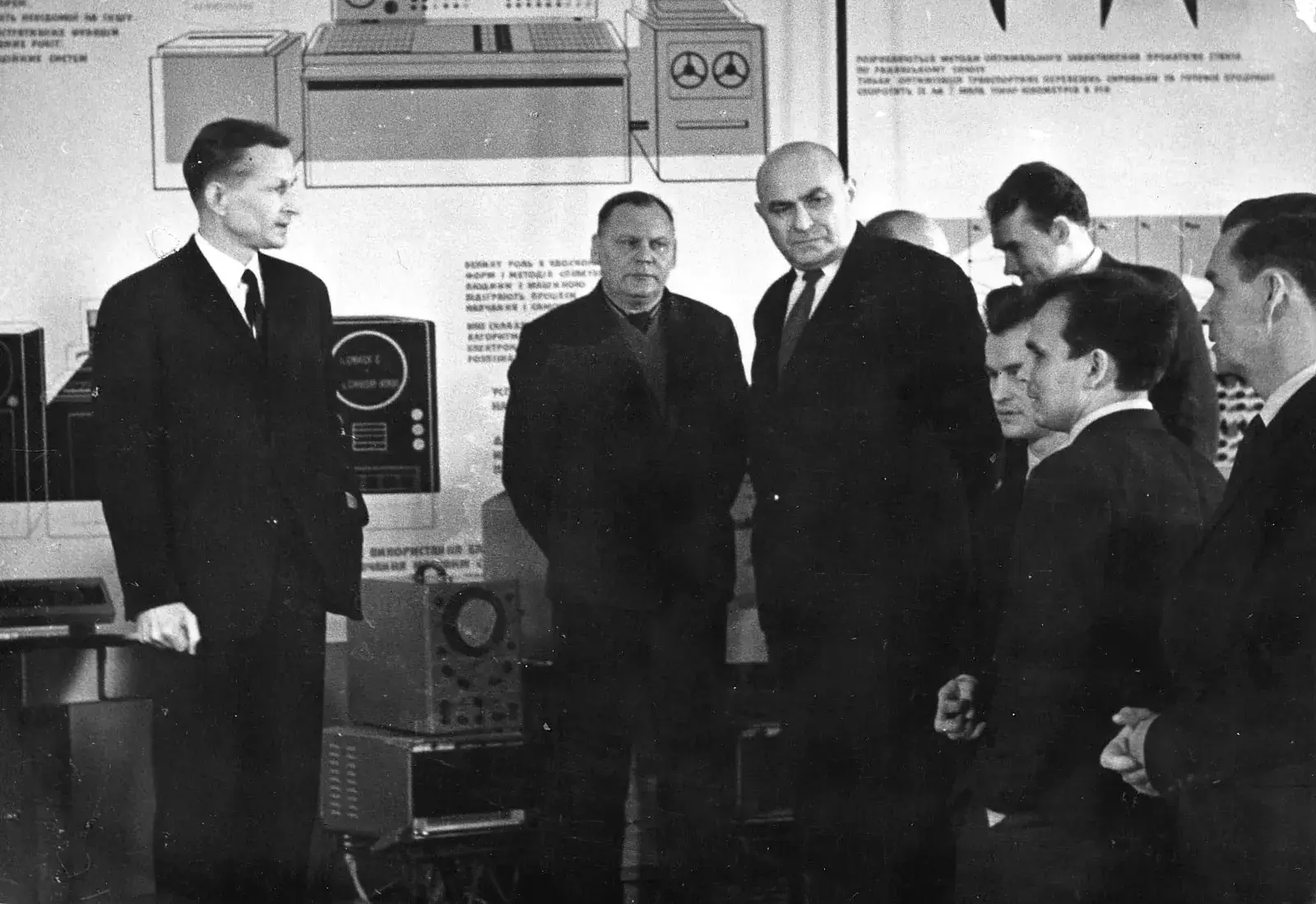
Matvey Kotlyarevsky, the director of the Radiopribor plant (in the middle), and Boris Malinovsky, the chief designer of the Dnipro computer on the left, at the Republican Fair of Ukraine. Kyiv, 1962, Unknown photographer. Source
The Kyiv computer project was launched as a collaboration between the Ukrainian Academy of Sciences Computing Center (the future Kyiv Institute of Cybernetics) and the Radiopribor plant.
“This saved us at least two more stages because the development was immediately customized for the plant's technology.”
Contrary to the conventional sequence of prototype creation followed by commissioning, Glushkov's approach streamlined the process. As he explains in his memoirs, usually, “an institute makes a prototype, then a commission comes, writes comments, then the weaknesses are addressed, and the prototype is submitted again, then the manufacturing plant is selected within six months or a year. When the manufacturing plant is chosen, the designers and technologists from this plant come and say, for example, we do not know how to drill these holes, we do not have a press for such a rack, and everything has to be redesigned. So, this all takes a lot of time.”
Learning & Development for Victor Glushkov’s Team
In the 1950s, Victor Glushkov found himself in a unique situation: he had to hire people and shape teams while there were no experienced specialists as the industry was yet to be formed. Glushkov turned to a formidable focus on personnel training and development, a legacy he would cherish and be proud of. As he outlined in his memoirs, “The work covers all levels — first, those who already work at the institute. Various seminars, including scientific and educational ones, were created for them, and lectures were given as the machine design theory developed. Thus, in a few years, it was practically possible to move from intuitive design to meaningful logical structure, first for individual block diagrams, individual sections of block diagrams, and then the whole machine.”
1. Starting from the Basics
In the 1950s, computer designers in the USSR mostly worked on their intuition. Many were never exposed to computers before they built one or tried cracking an American example and doing reverse engineering without proper documentation. Even competent engineers struggle to comprehend how an electronic computing machine works, also due to the overcomplicated literature written on the subject. Glushkov had mastered computing machine theory and stated: “Ultimately, I figured it out myself and started developing my understanding of how the machine works. Since then, the theory of computing machines has become one of my specialties. I decided to turn machine design from an art to a science.”
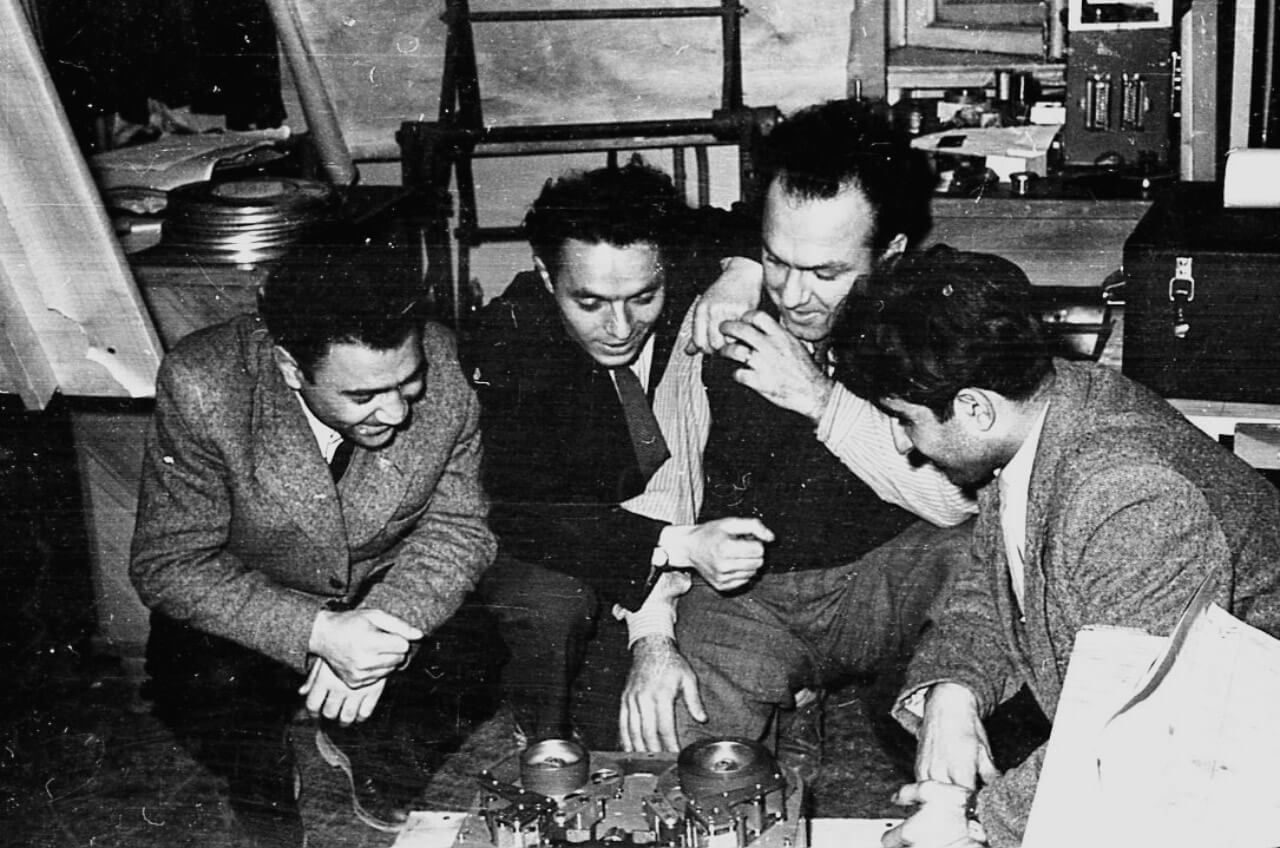
Before the experiment with the tape drive. Yerevan Institute of Mathematical Machines, 1960. From Radik Ananyan’s archive.
Glushkov’s journey began in Kyiv, where he started with a seminar, explaining and rewriting articles from American journal digests. A remarkable feat was the alignment of theoretical speculations with the practical application of a particular computer design, resulting in the creation of the first “Kyiv” machine. These educational seminars not only transformed Glushkov’s colleagues from electrical engineers into pioneers of this novel knowledge domain but also laid the cornerstone for the institute’s core team.
2. Cooperation with Universities
The Institute of Cybernetics needed personnel, which is why alongside all the projects involving huge industrial enterprises, dealing with top officials, and building a computer plant, Glushkov paid special attention to students. “For this purpose, we launched specializations in computational mathematics and computer science at Kyiv State University and Kyiv Polytechnic Institute's Faculty of Radio Engineering. Later, these specializations could be turned to the Faculty of Cybernetics at KSU and the Faculty of Automation and Computer Science at KPI.”
Despite USSR legal challenges in combining academic and governmental duties, which he had to resolve at the governmental level, Glushkov demanded his leading staff members to lecture at these institutions there. The idea was to influence the learning process, ensuring the students received the needed knowledge and practical training to shorten their onboarding after graduation. This strategic alignment between the curricula and the Institute of Cybernetics culminated in a significant influx of these specialized alumni into the institute’s workforce.
“I also demanded that all employees on business trips to Ukrainian cities with universities close to our specialties visit these universities, lecture there or hold consultations and get acquainted with the students to make selections before distribution. Even in the third or fourth year, we would find out that in Kharkiv or Lviv, there are capable guys whom we should invite to the institute.”
3. Expanding the Network
Besides working with students in different cities, Victor Glushkov’s team embarked on a mission to popularize the use of computers across various domains. First, they launched lectures for engineers retraining in Kyiv and spread the network of cybernetic schools throughout Ukraine. This strategic move granted that by the time of mass production of machines designed by the institute, a skilled pool of specialists would be well-equipped to operate them.
“Then we worked with schoolchildren. From the start, we patronized some high schools where we started teaching programming. Then we began to organize all kinds of contests and olympiads at the Institute of Cybernetics and launched the Small Academy of Sciences for schoolchildren in the Crimea, where in summer they listened to lectures.”
In the late 1950s, the Institute of Cybernetics organized a boarding school in Feofania ?The place where MESM, the earliest European computer, was assembled and launched in 1951. Later, it was transferred to Kyiv University, where it became a school for future physicists and mathematicians, although its origins were exclusively tied to cybernetics.
Glushkov’s team did not only help form the boards to award academic ranks in computer science; the middle technical personnel, tasked with operating the machines were also a priority. Victor Glushkov recalls in his memoirs, “We proposed reclassifying the technical school in Lviv Square to train specialists in electronics, and the Central Committee and the Ministry supported us. I do not remember this technical school's earlier name, I gave two lectures there, and all the teachers and the management got excited.”
“A solid base for training both developers and users was created in Ukraine.”
4. Career Paths Creation
For those who delved into computer design and software development during the 1950s, 1960s, and 1970s, building an academic career was the norm. And Victor Glushkov paid much attention to his team members' growth. Workshops offered opportunities to improve their qualifications. But it also concerned the research process itself.
“…the topics were chosen and people arranged in such a way that the topics were as much as possible in line with their interests (this minimized the period of their entry into a new field) and that they could defend their doctoral theses on these topics.”
This doctrine helped retain people and allowed newly awarded candidates and doctors of sciences to lead new postgraduate students. Glushkov says in his memoirs, “Already since 1960, new doctoral theses started appearing quite rapidly. We currently have 60 doctors of science, although we have given quite a few to universities and other organizations.”
Glushkov tended to give clear career visions to his colleagues and candidates. “I remember how Mikhalevich and I took a long walk through the forest in Feofaniia, and I told him that he would become a doctor of sciences later than his colleagues at the Institute of Mathematics. But that his further advancement up the academic ladder would be faster, and that he would vote for Korolyuk (in the elections to the Academy of Sciences of the Ukrainian SSR), and not vice versa. In the end, Mikhalevich joined us.”
In general, Victor Glushkov was an advocate of a transparent hiring process. However, institutes had to fight for highly trained specialists.
“Here I adhered to the position of fair competition: without hiding anything, I laid out my trump cards and expected that the other side would lay out theirs, and it was up to specialists to decide where they would go.”


